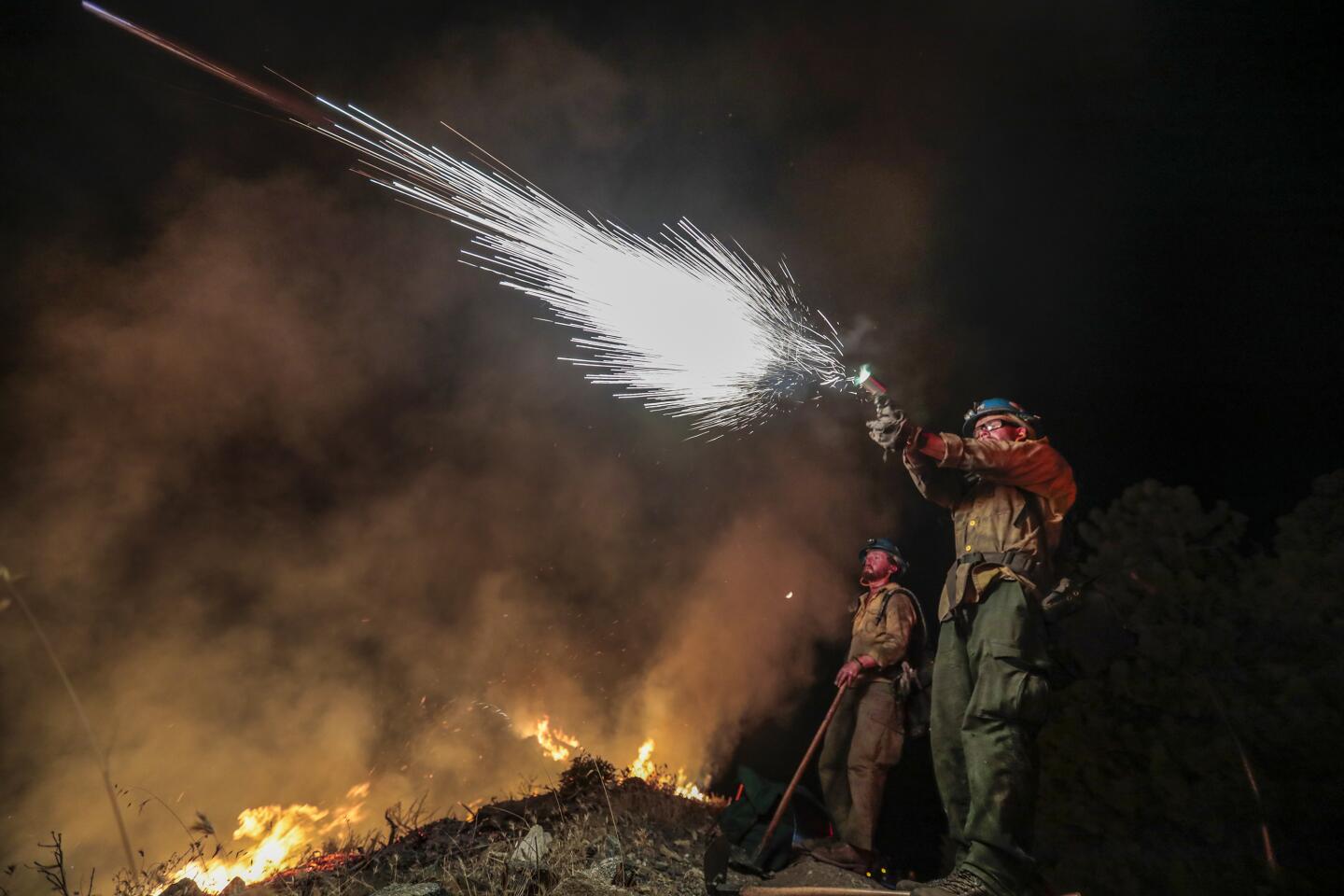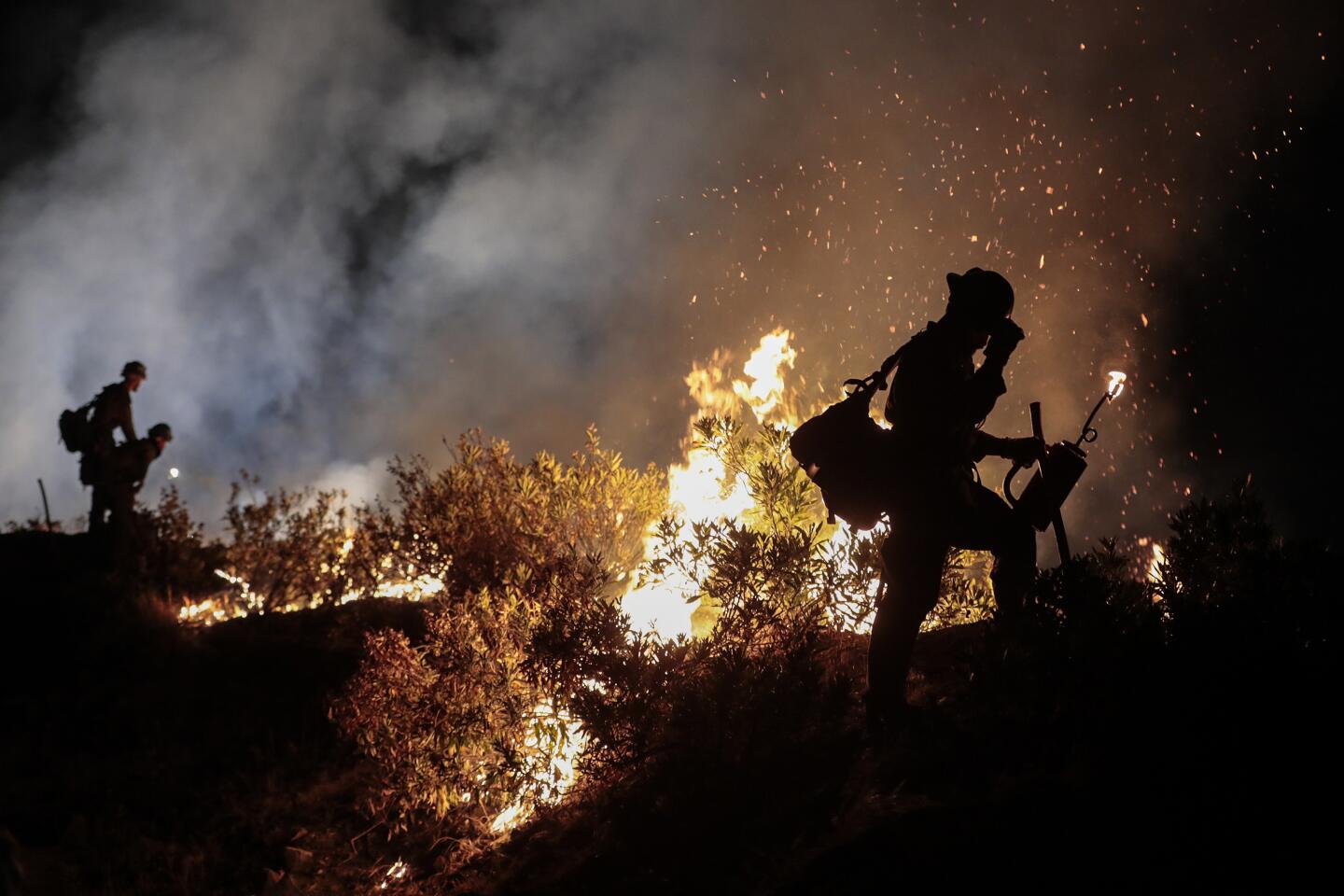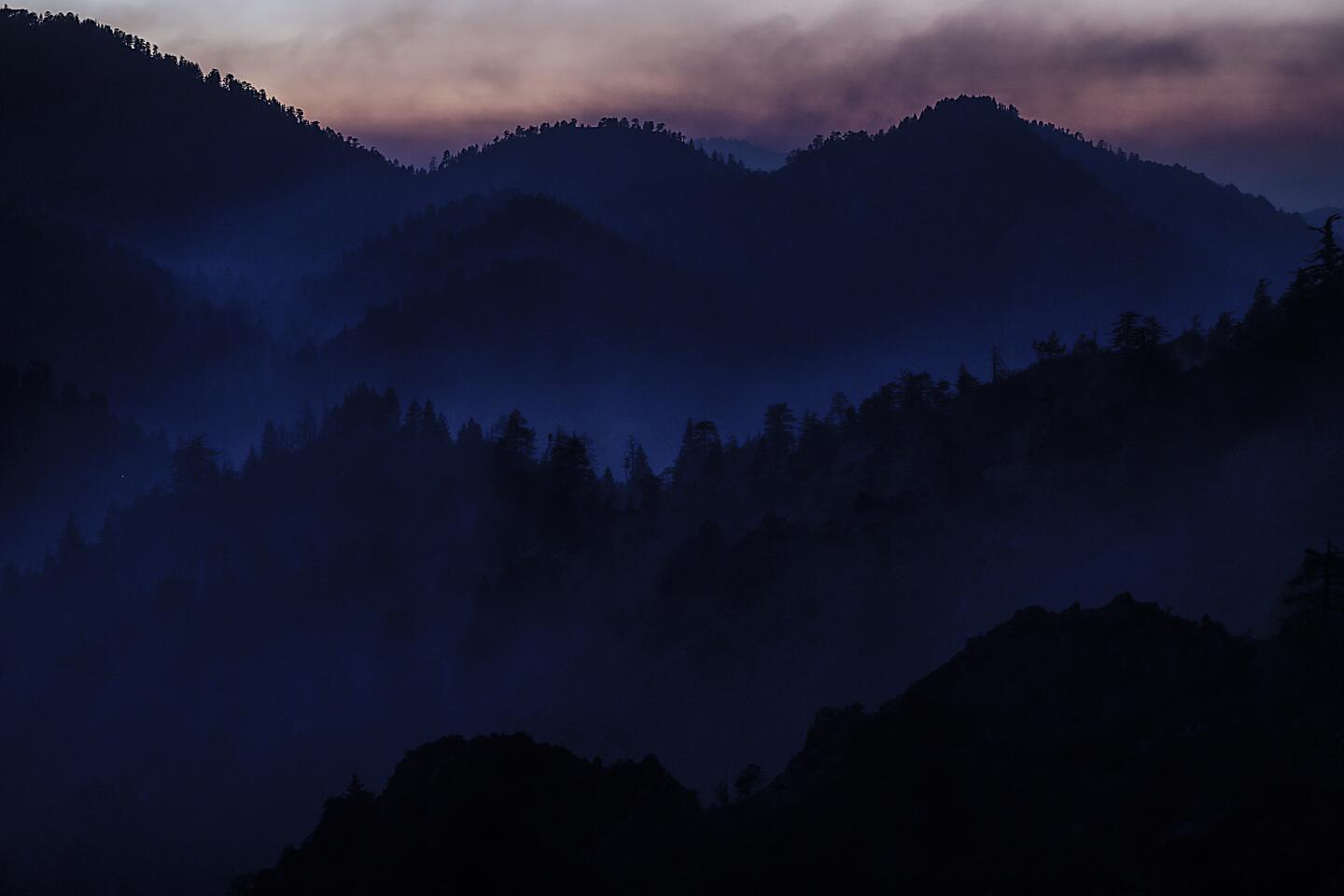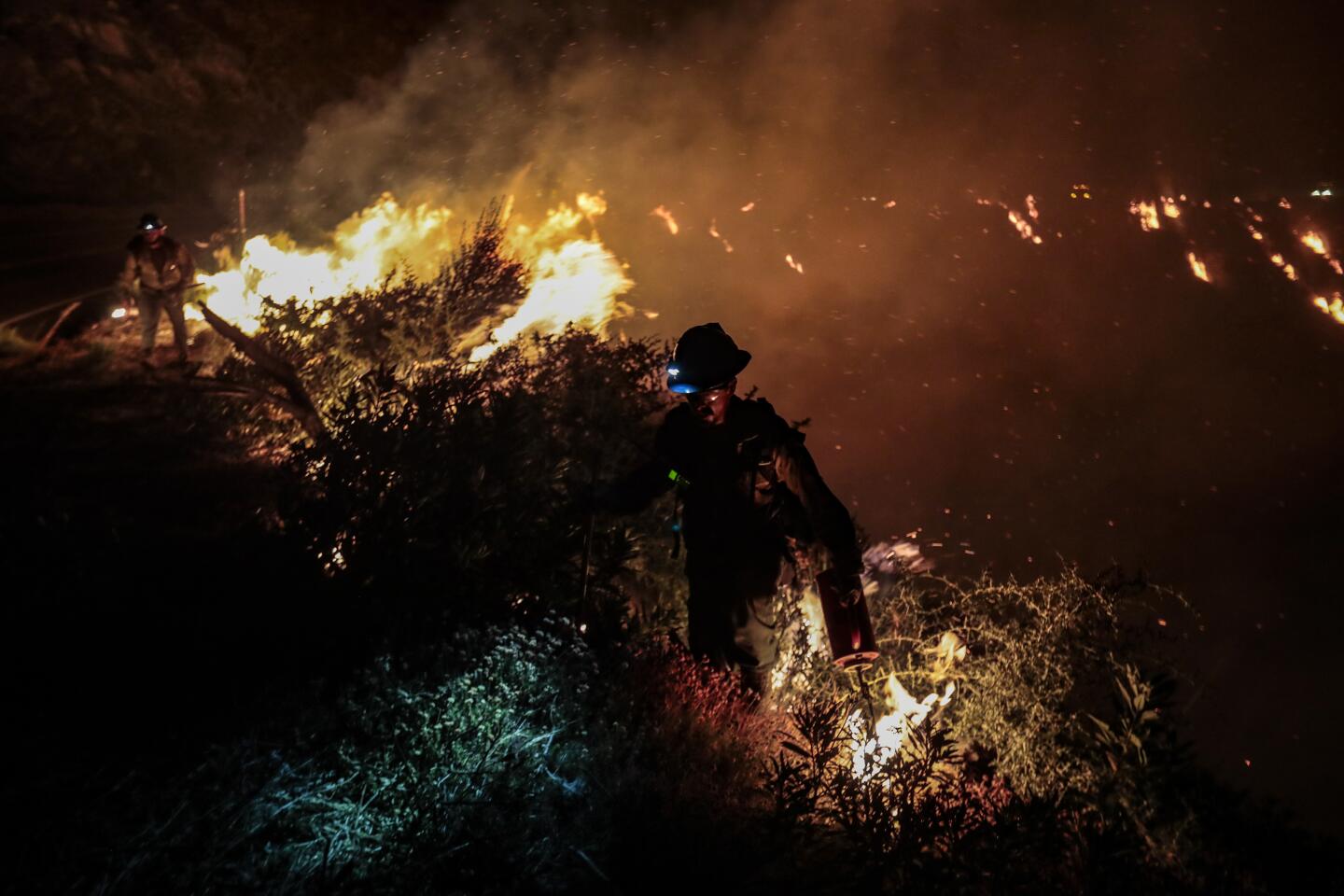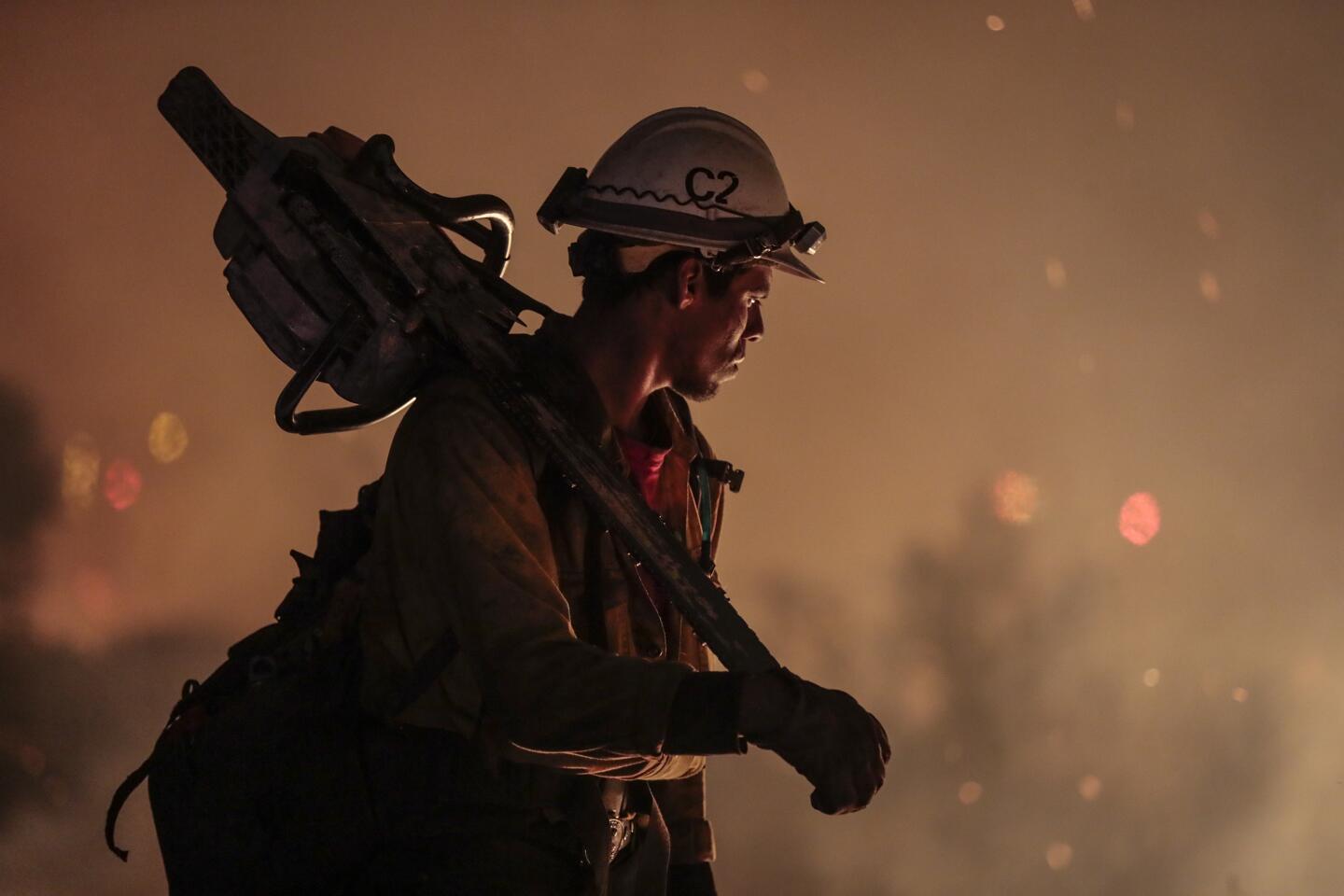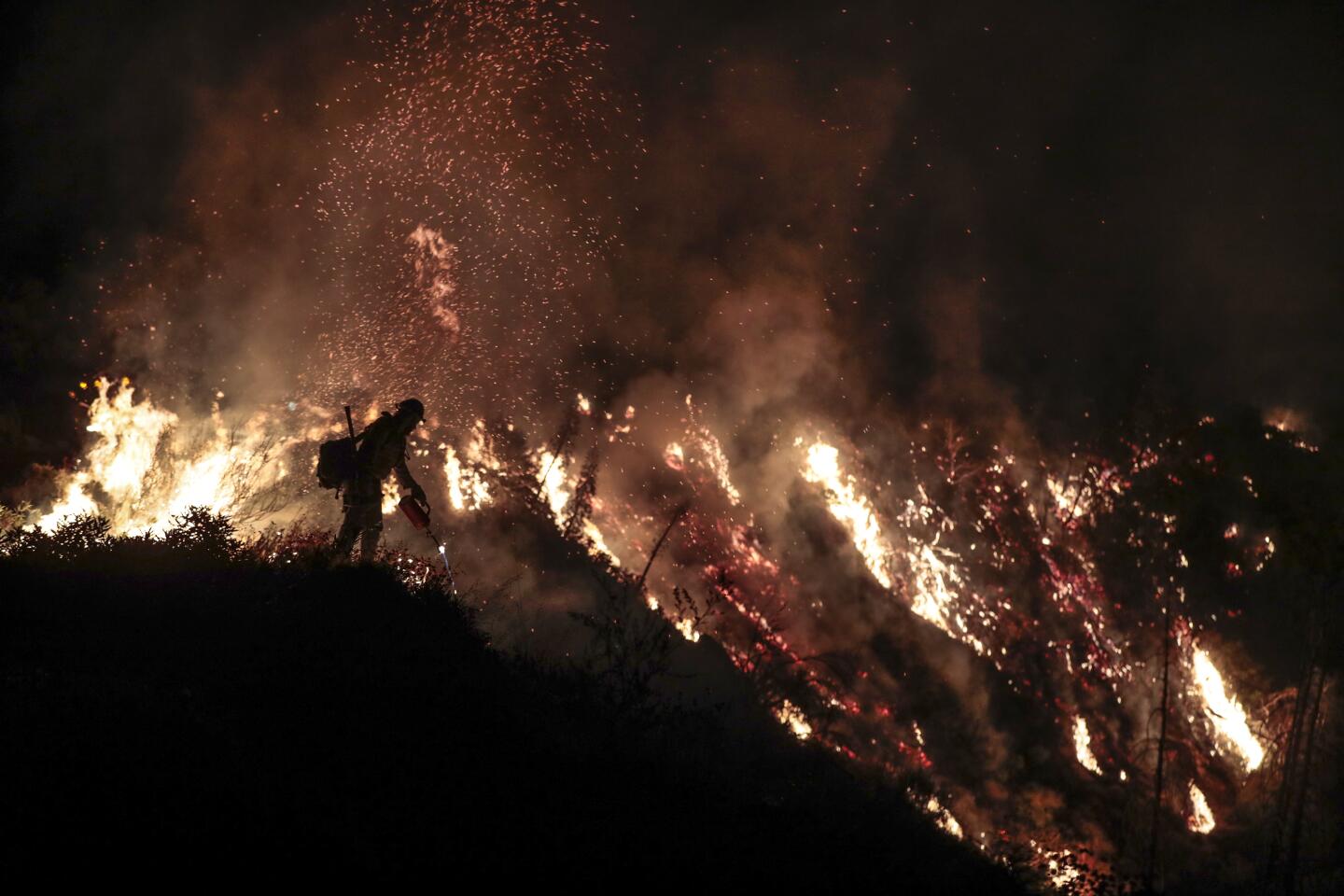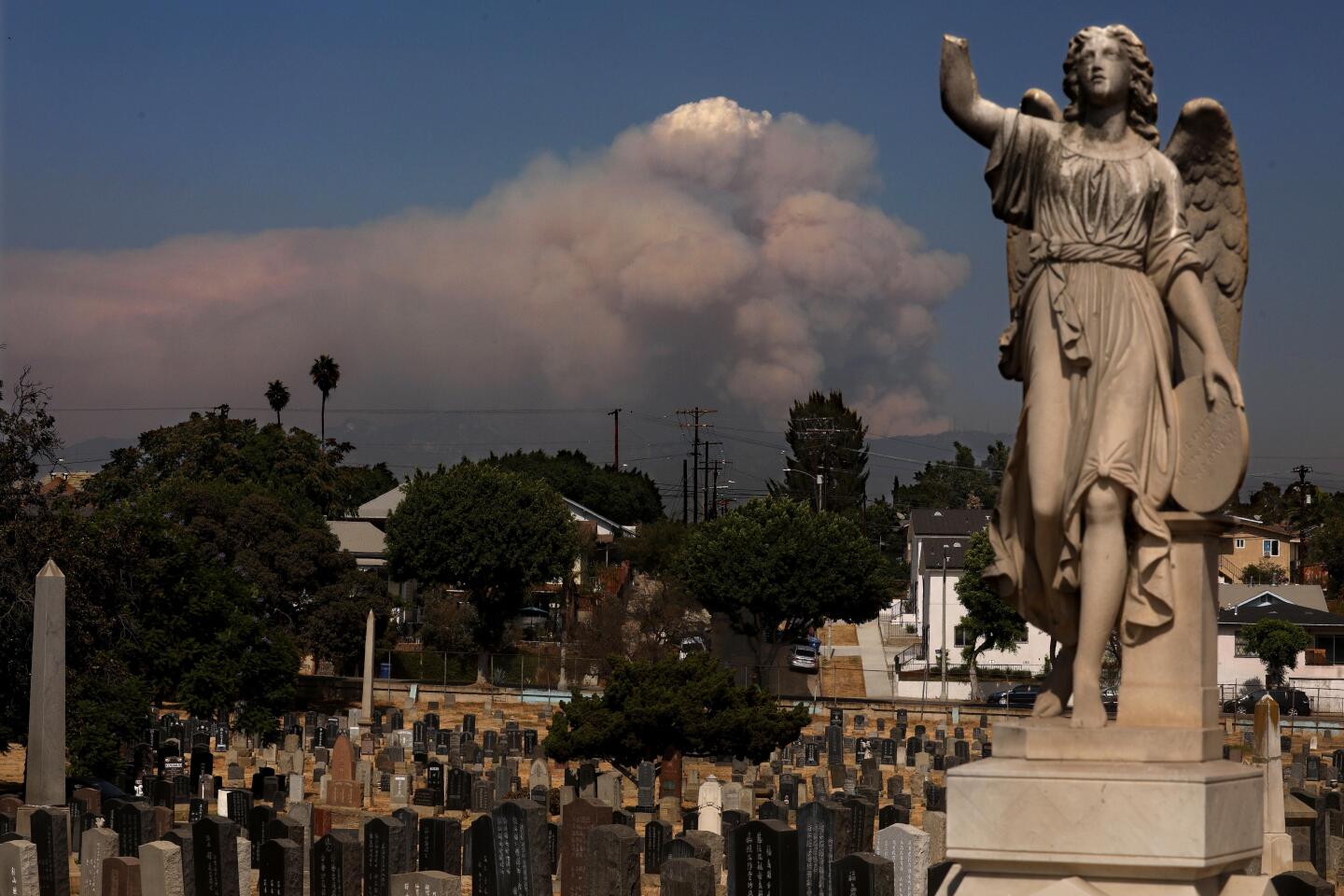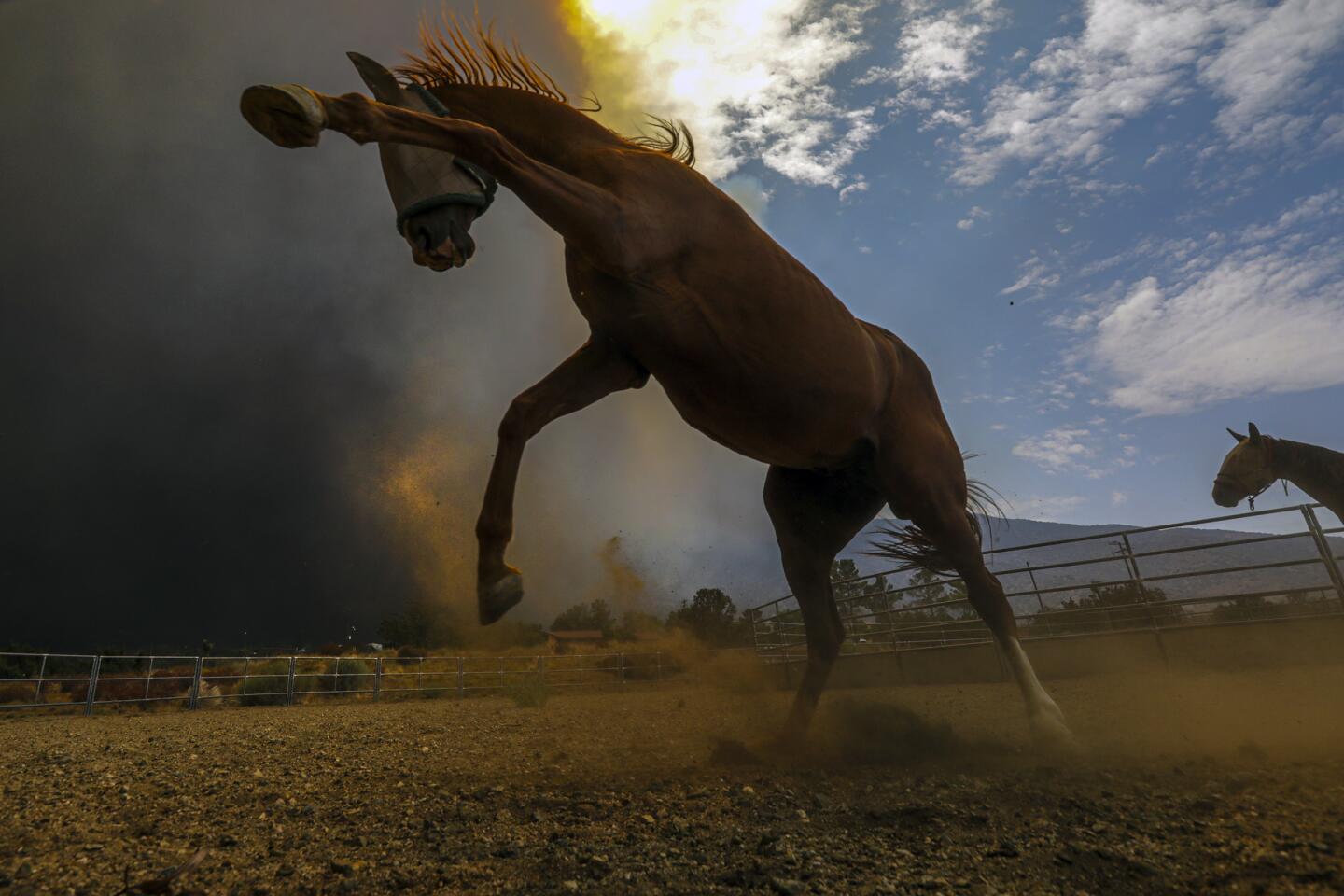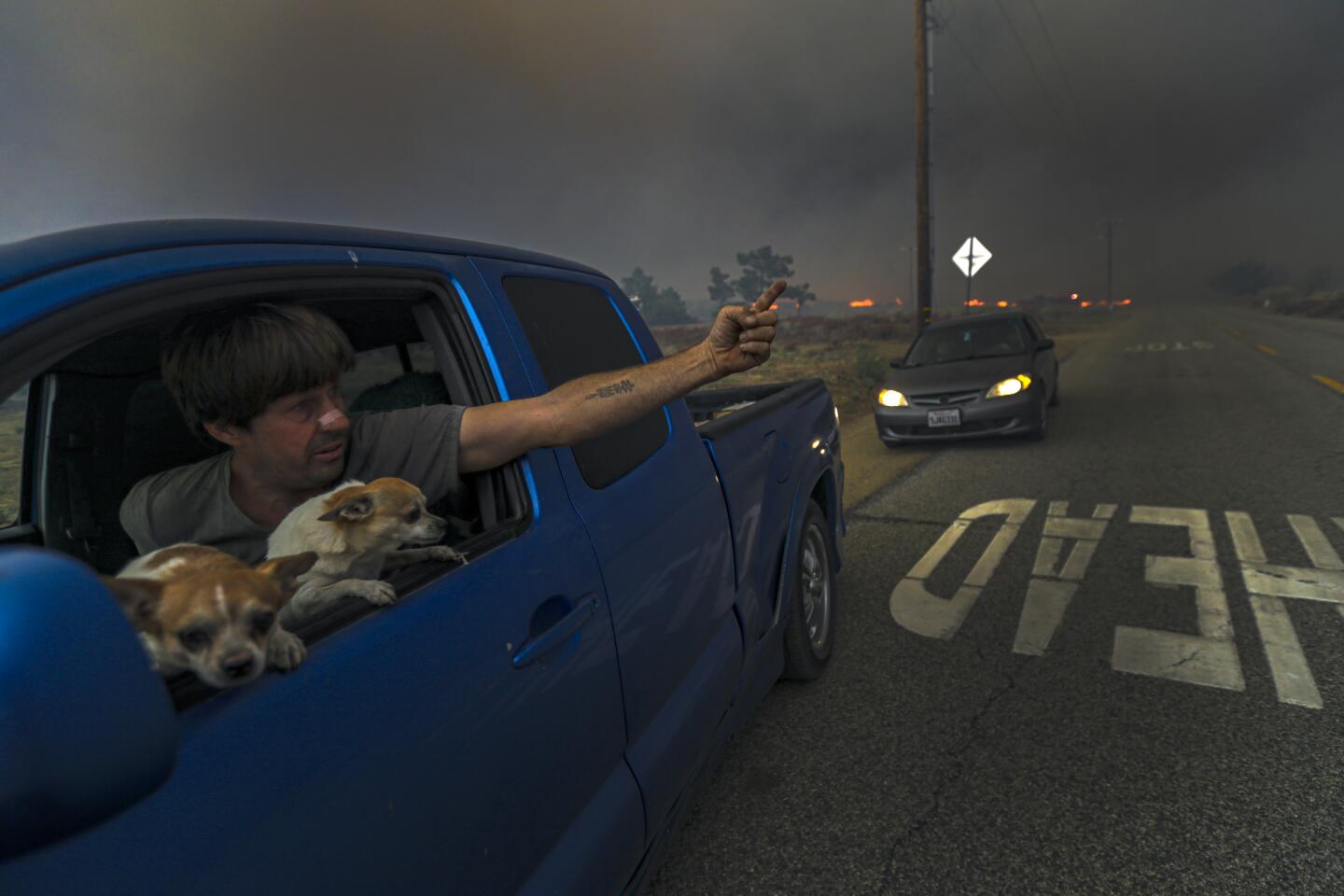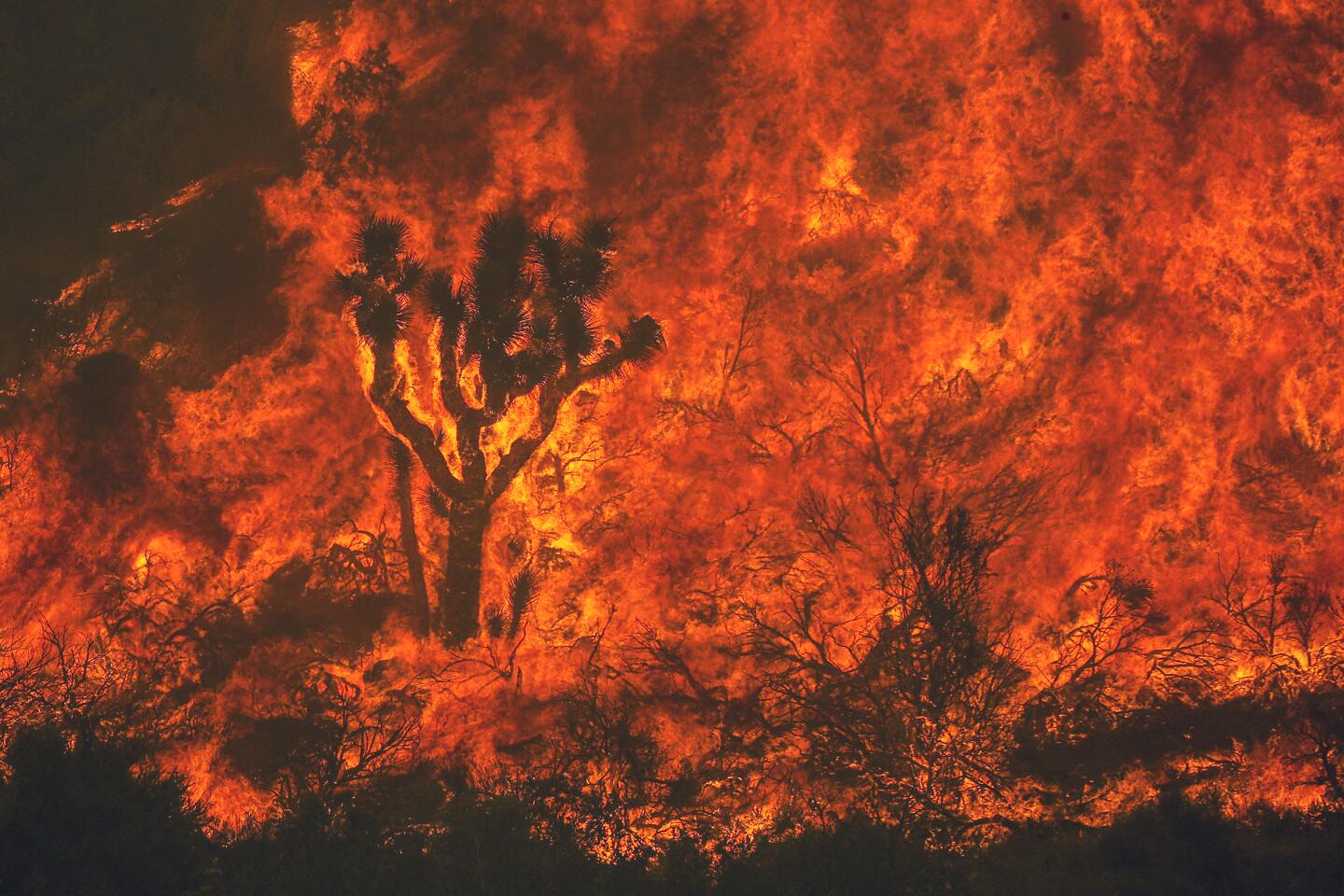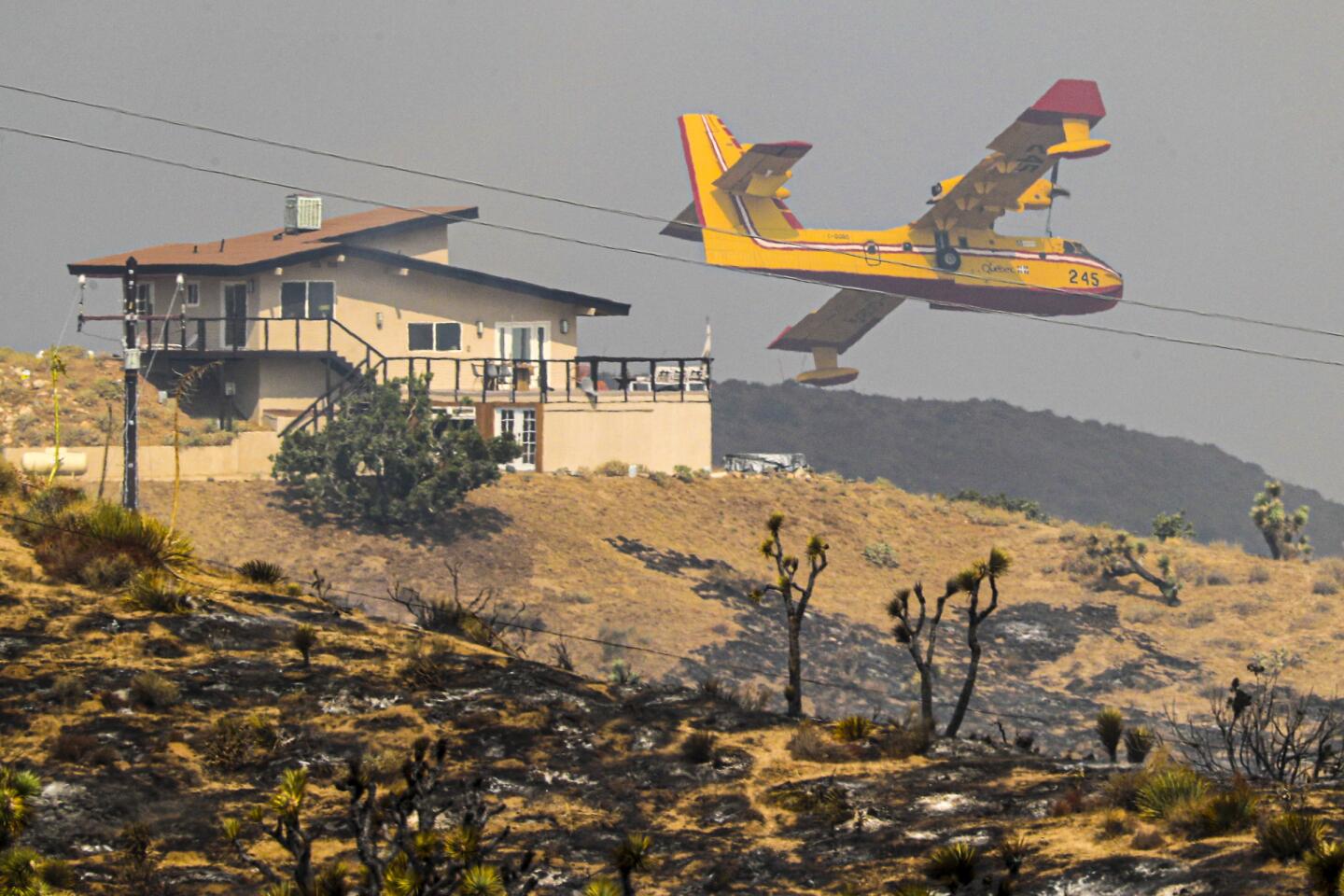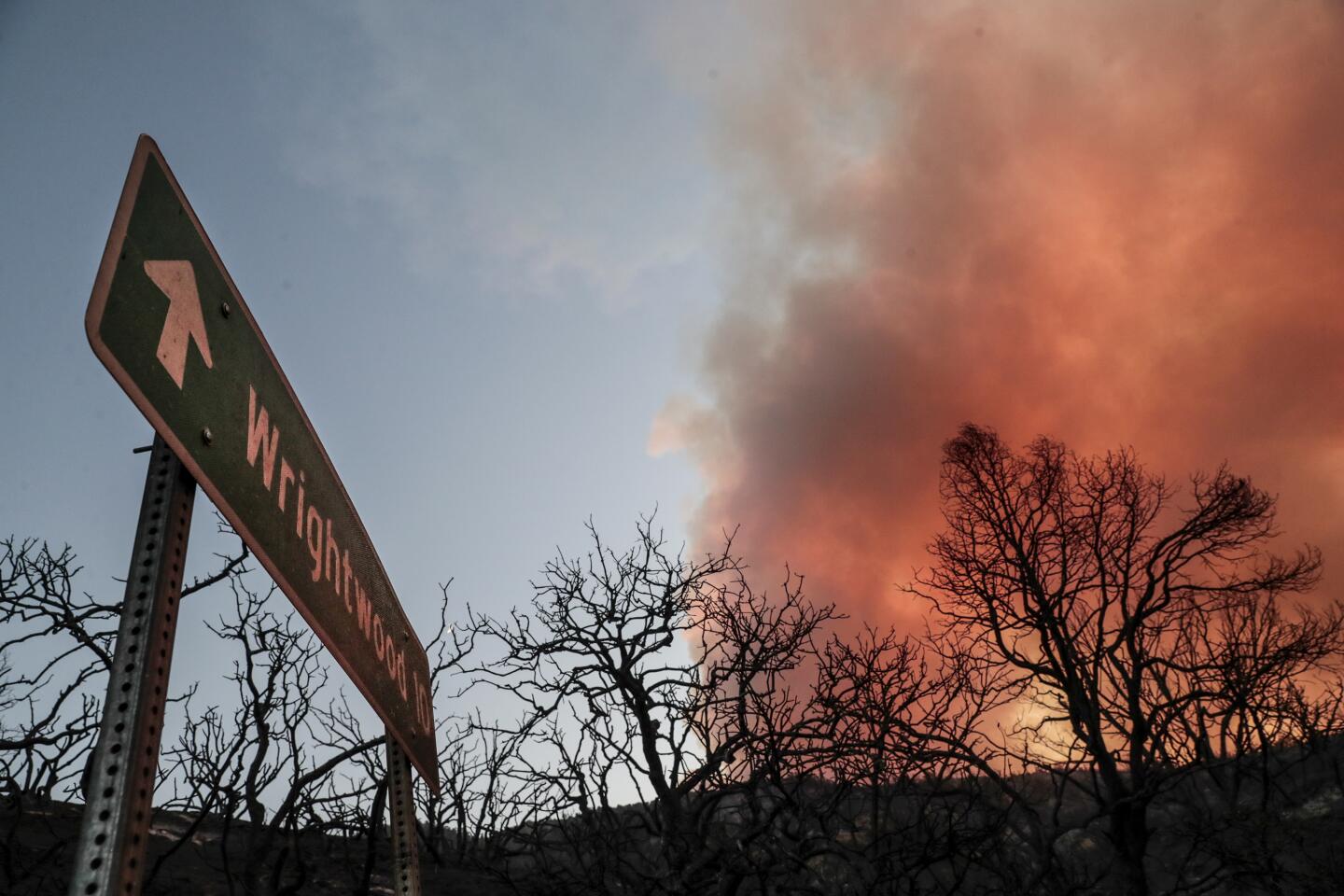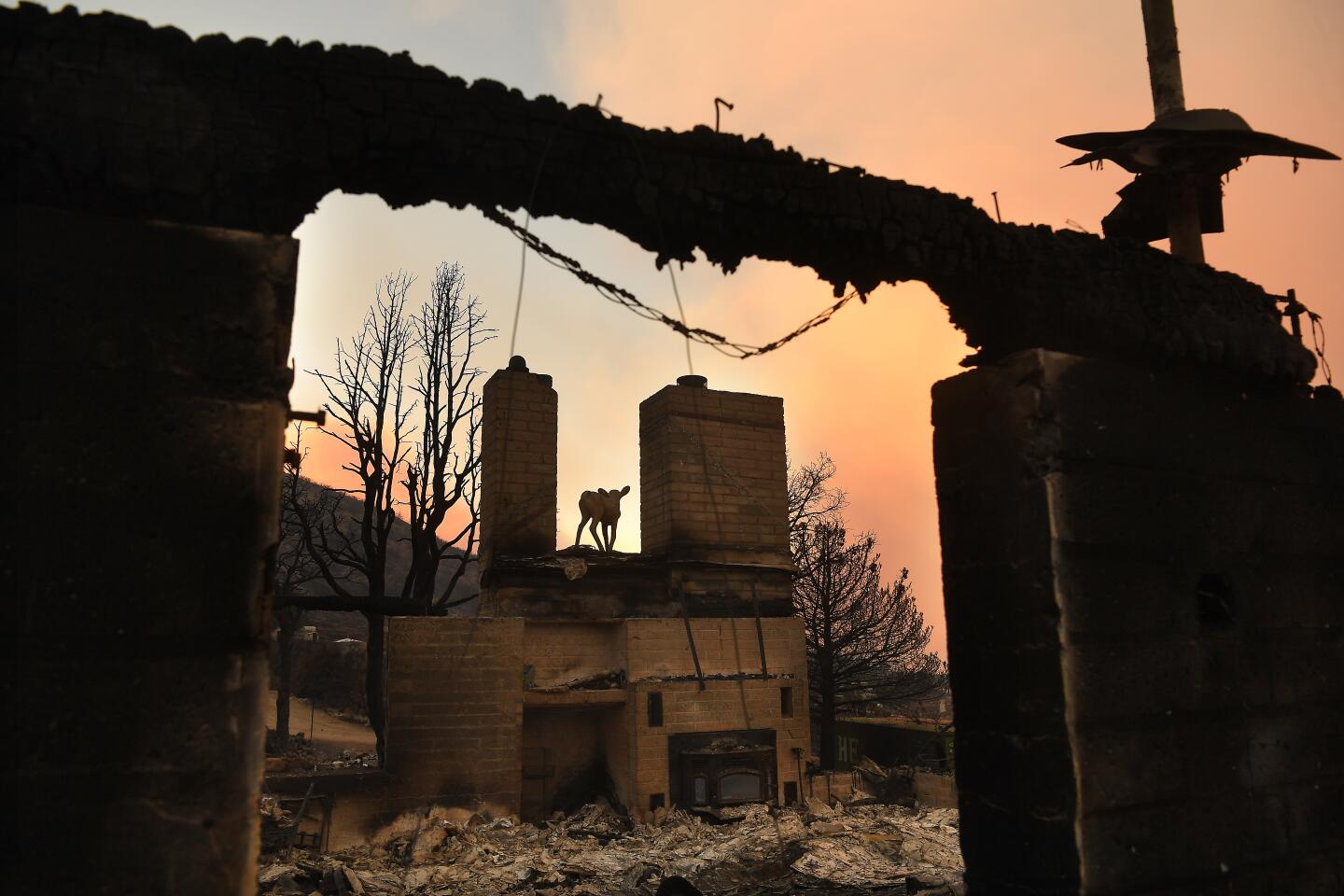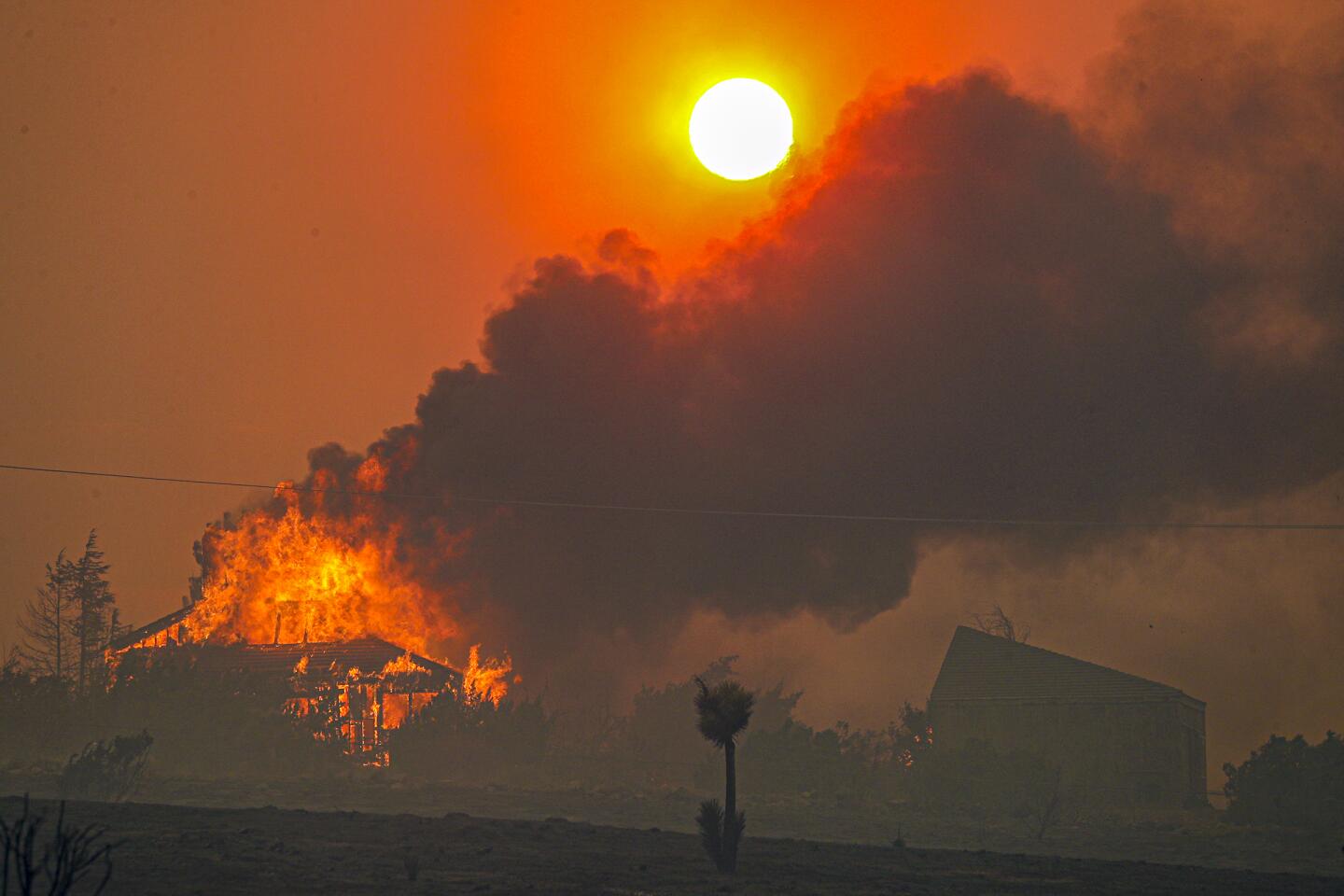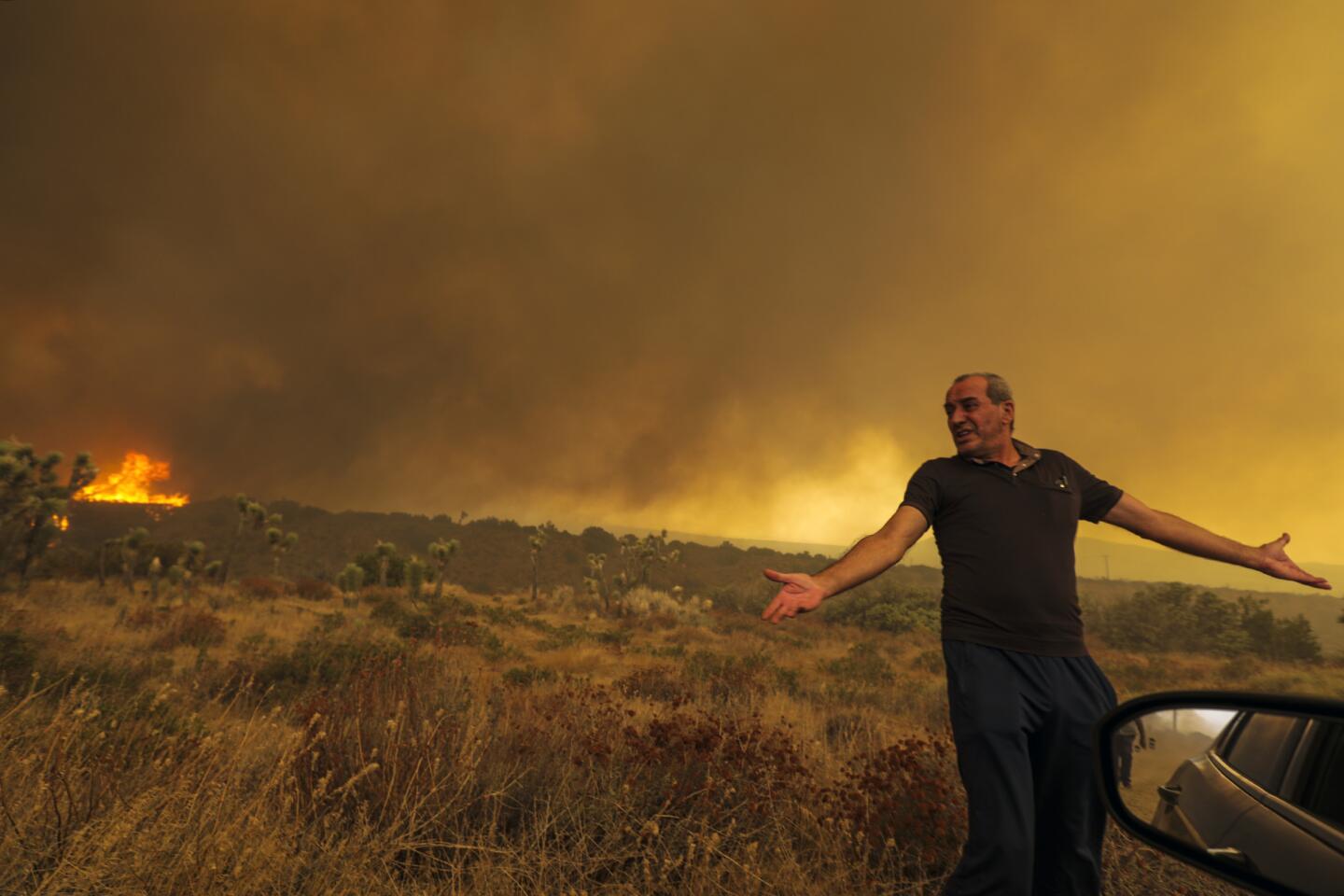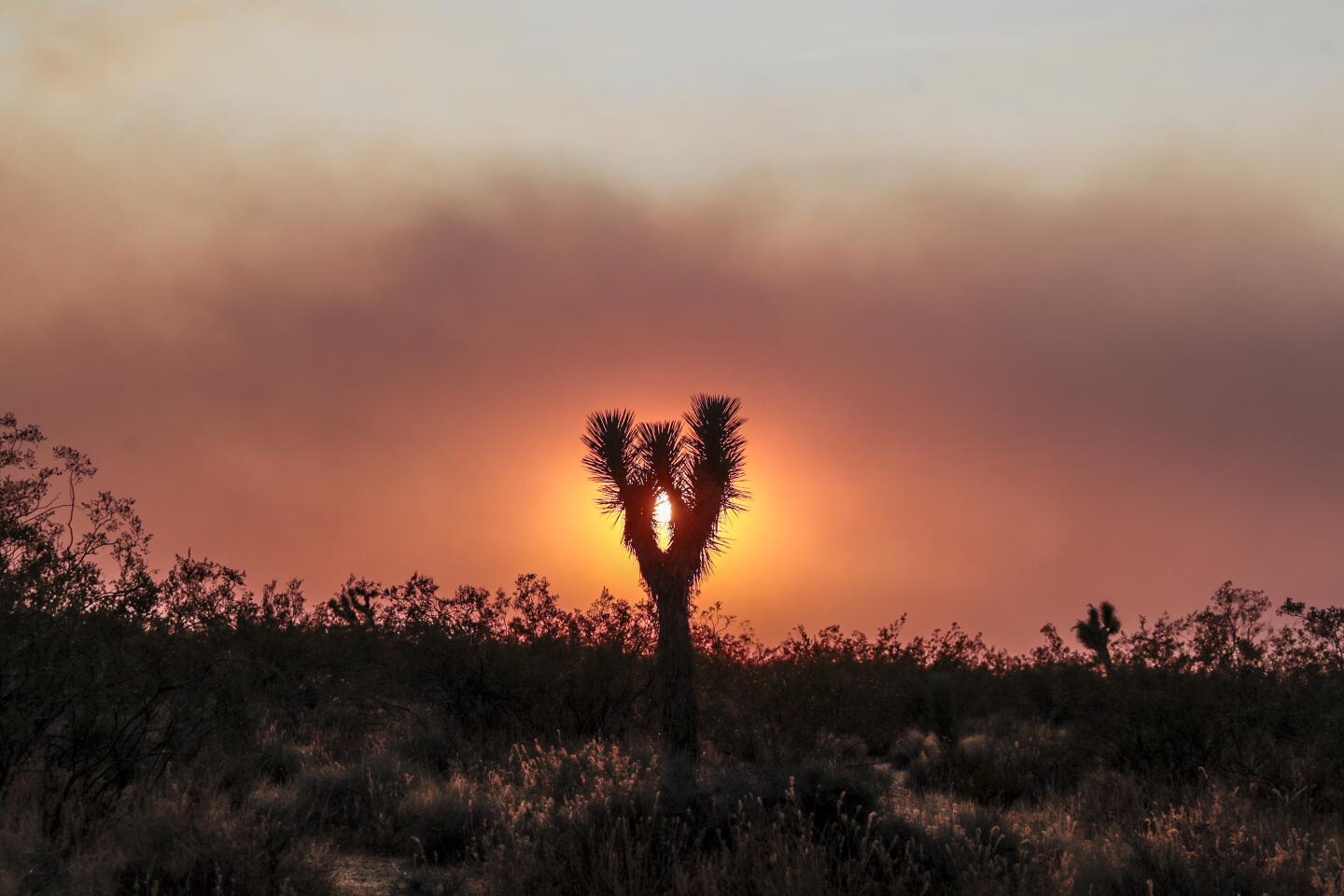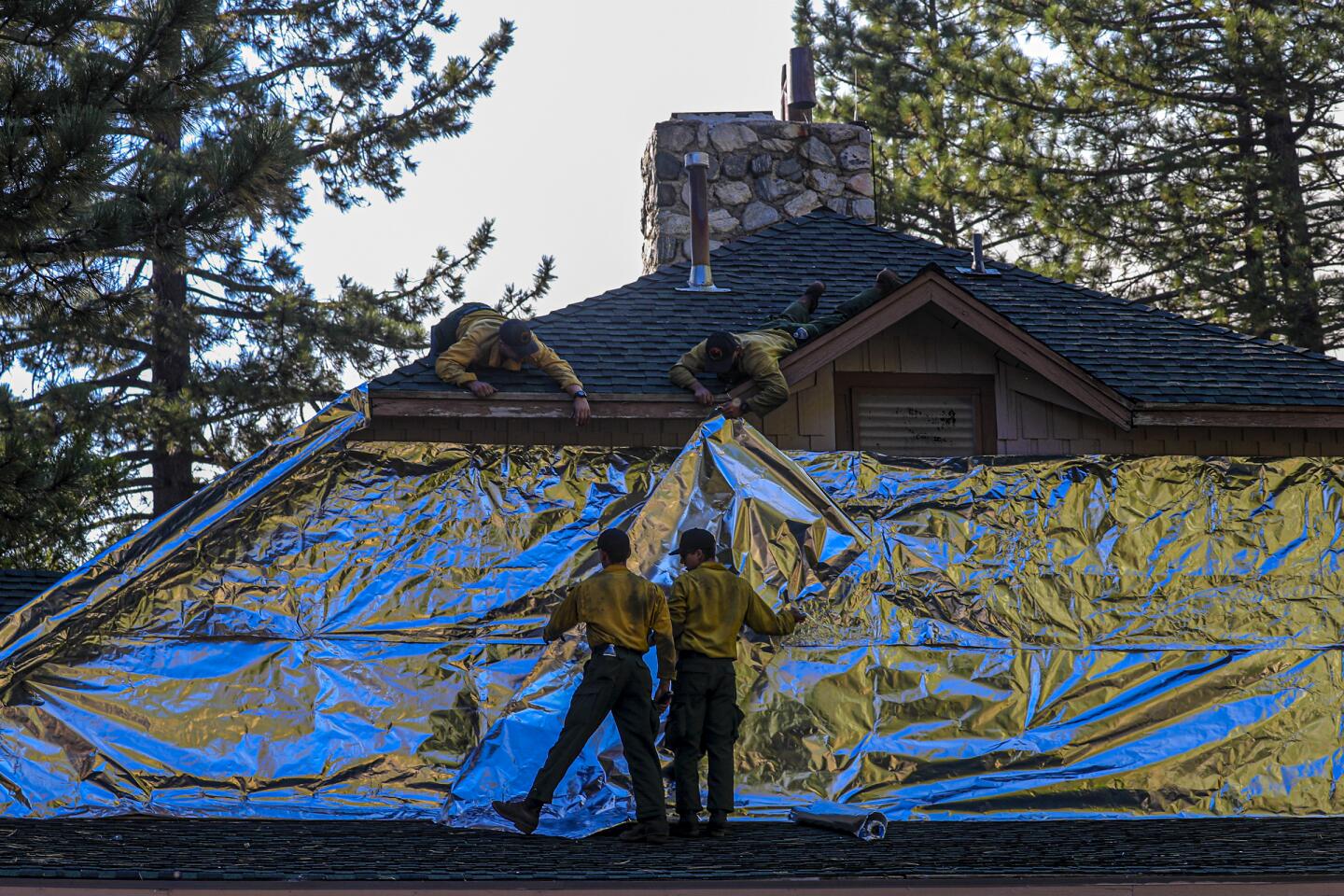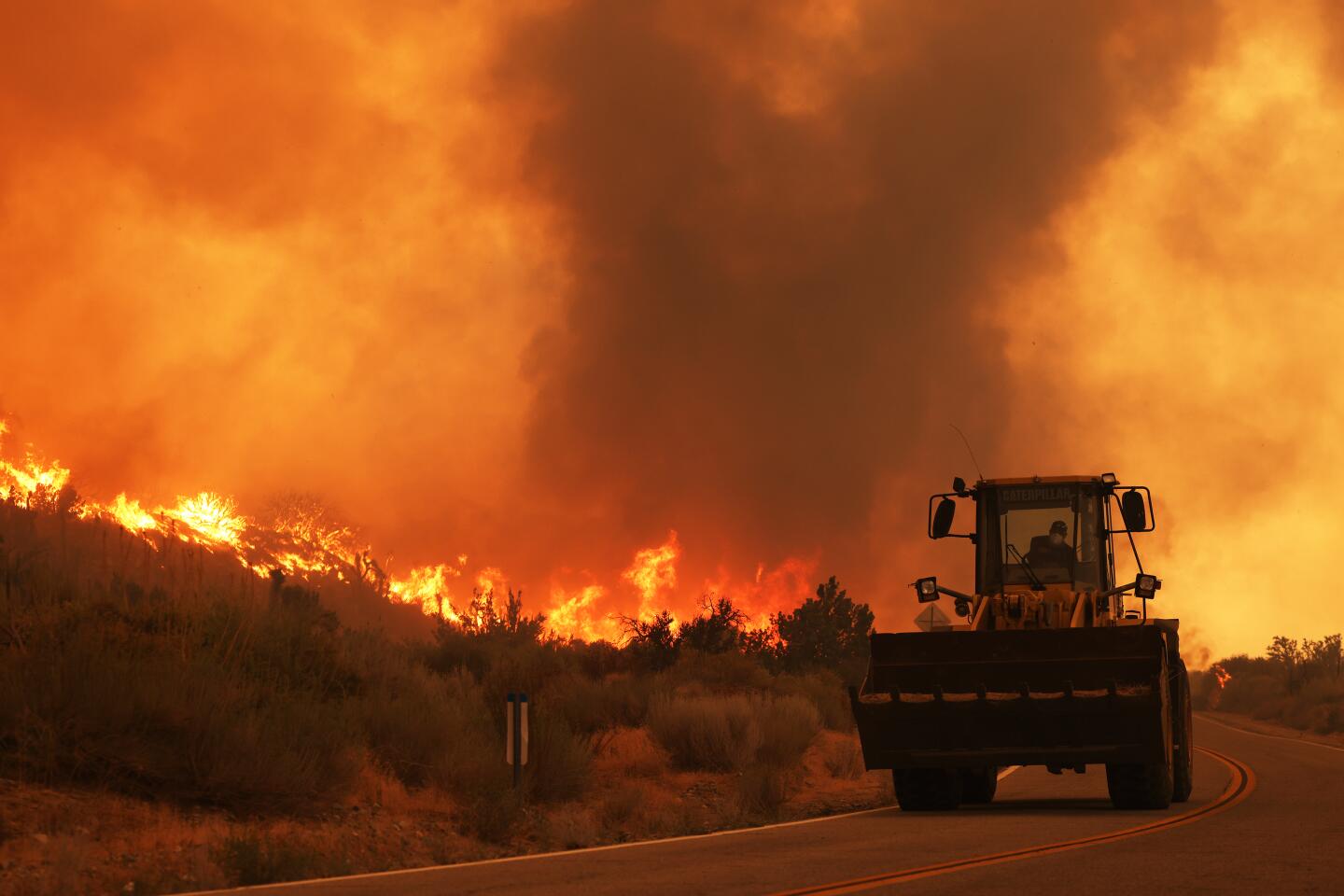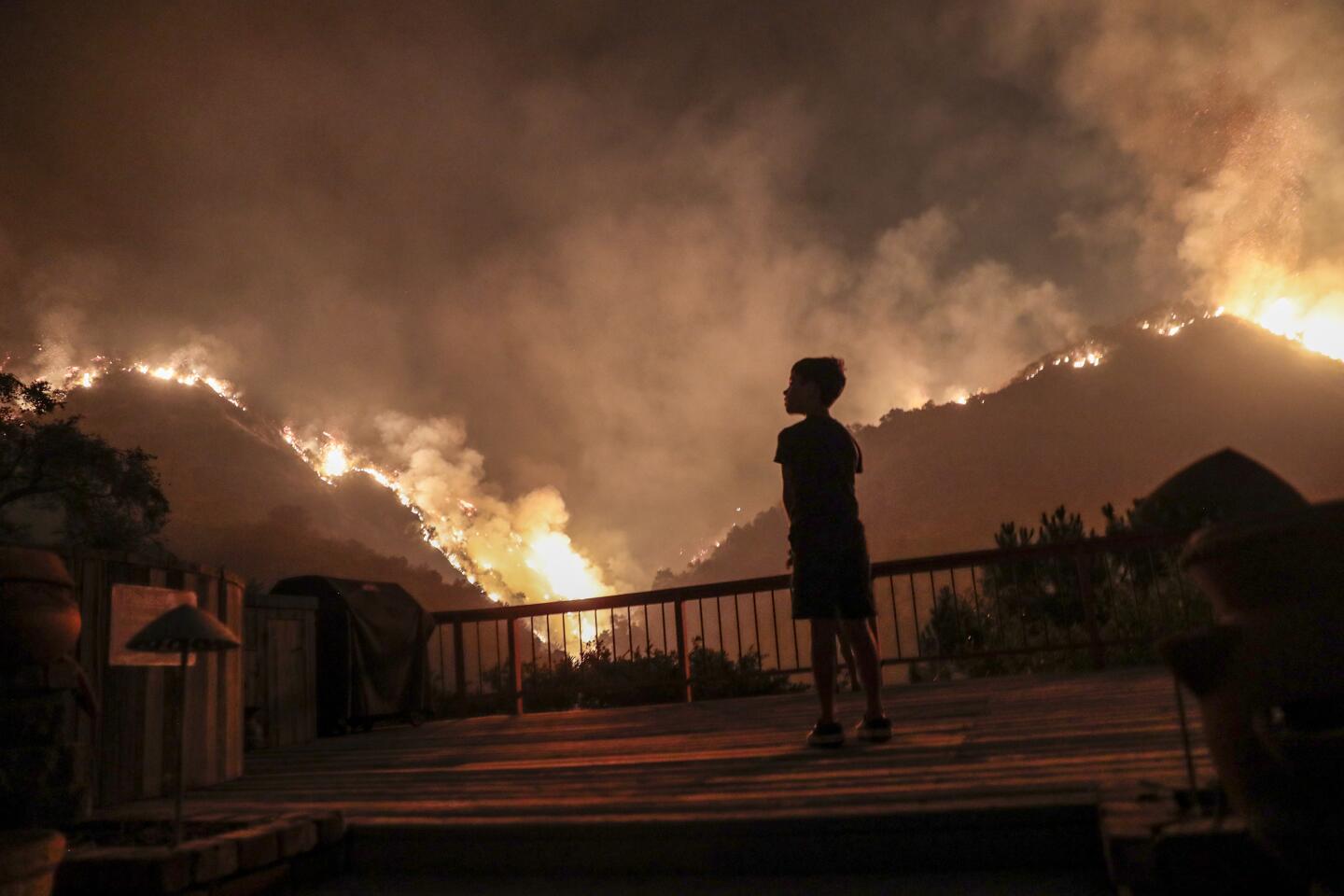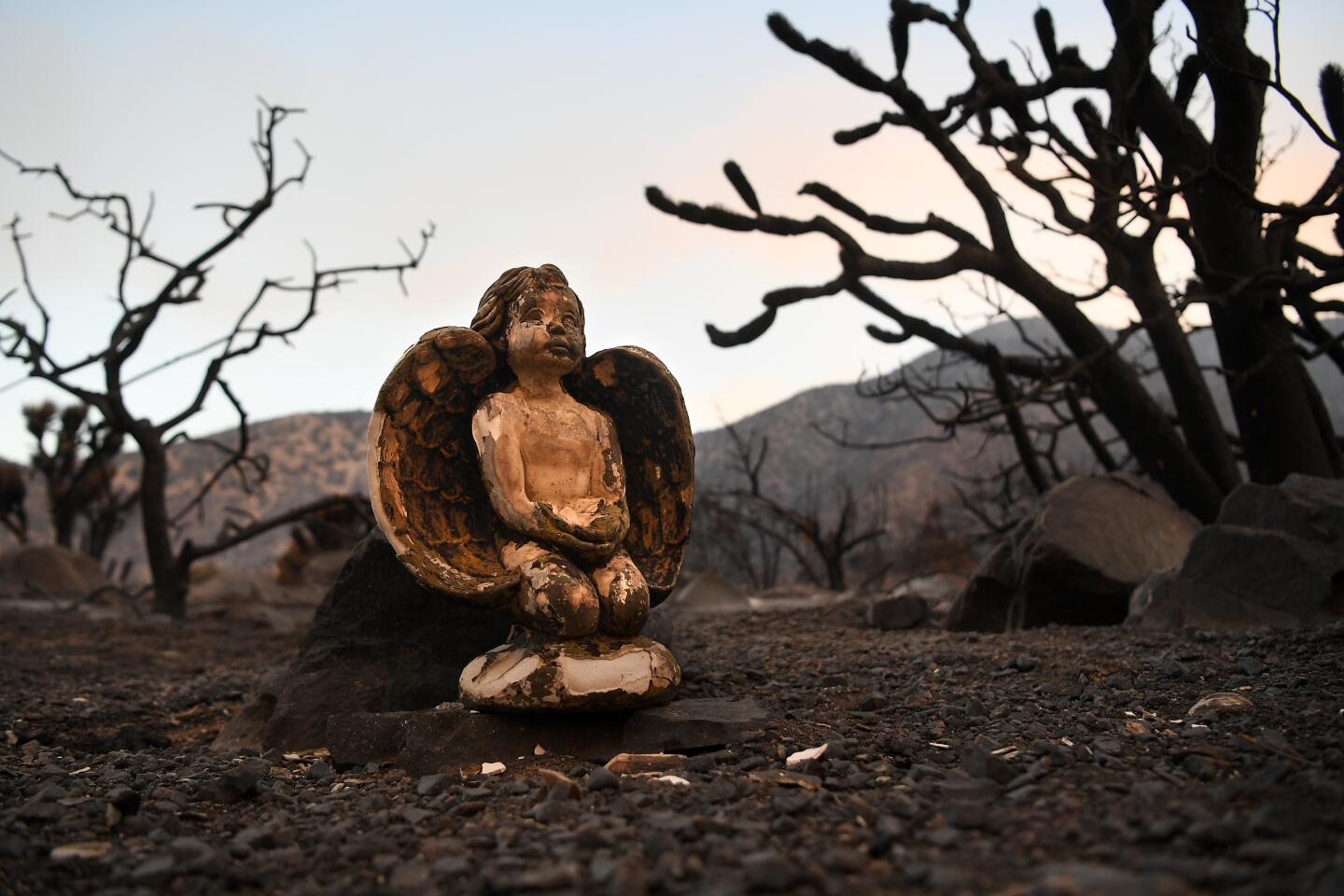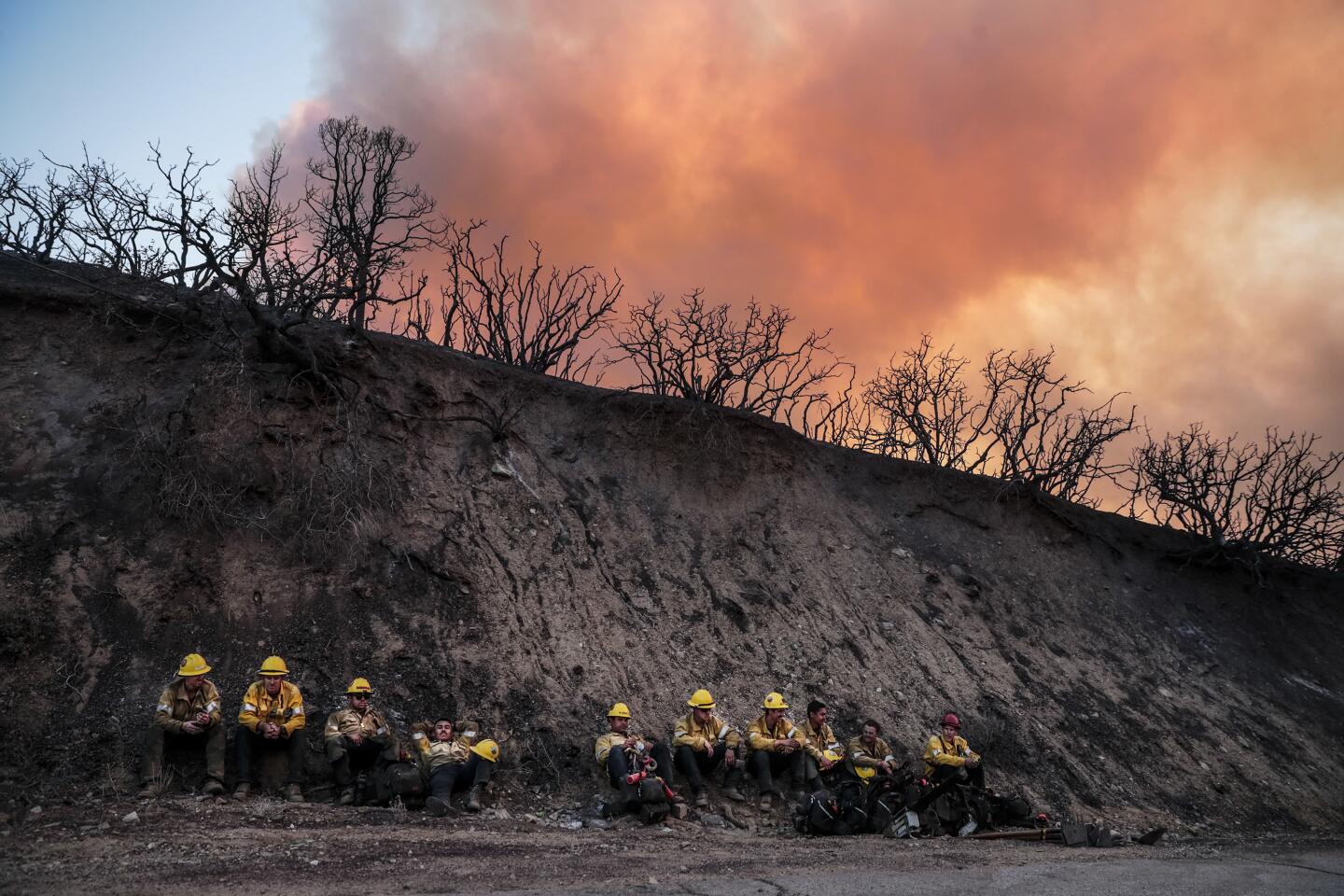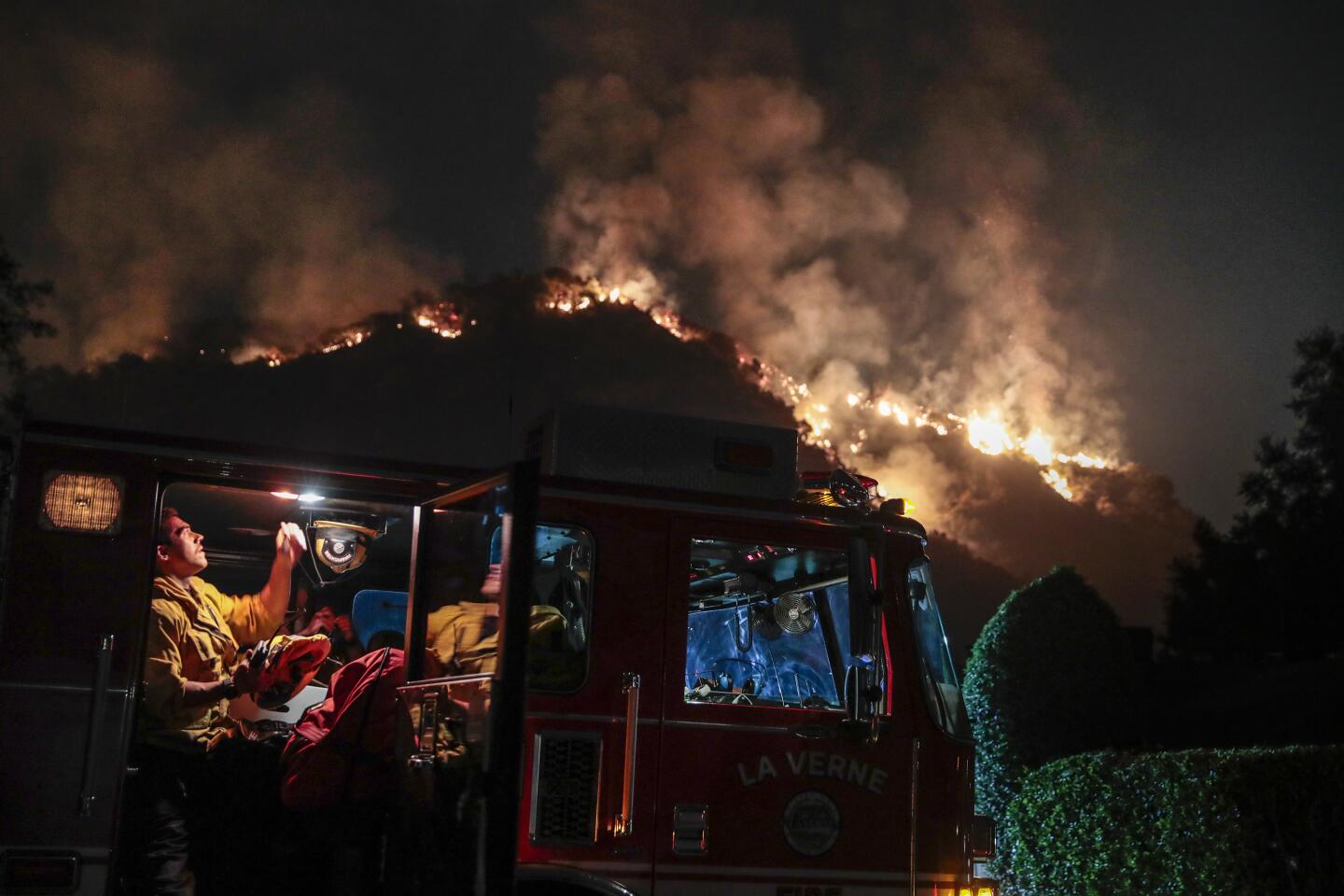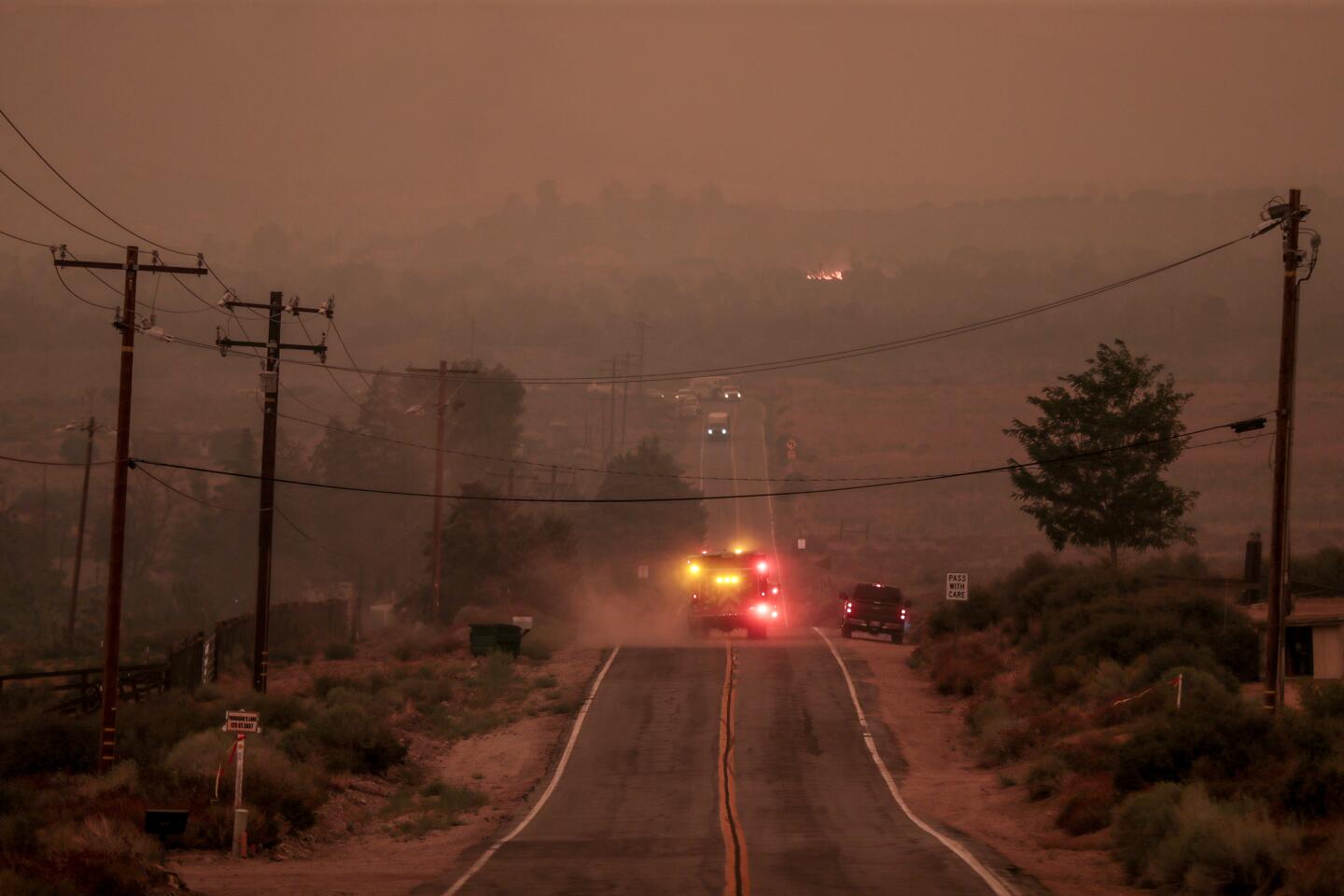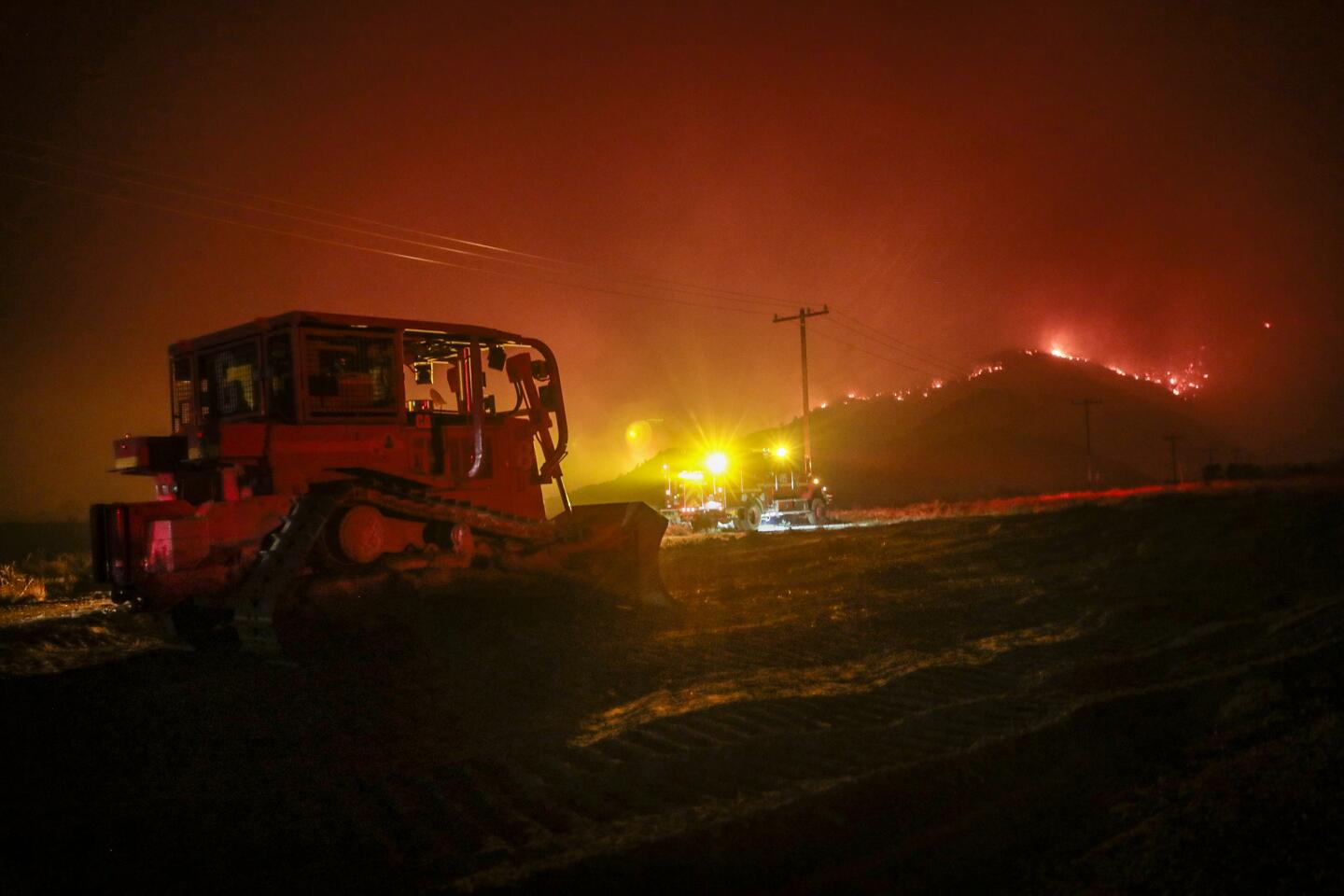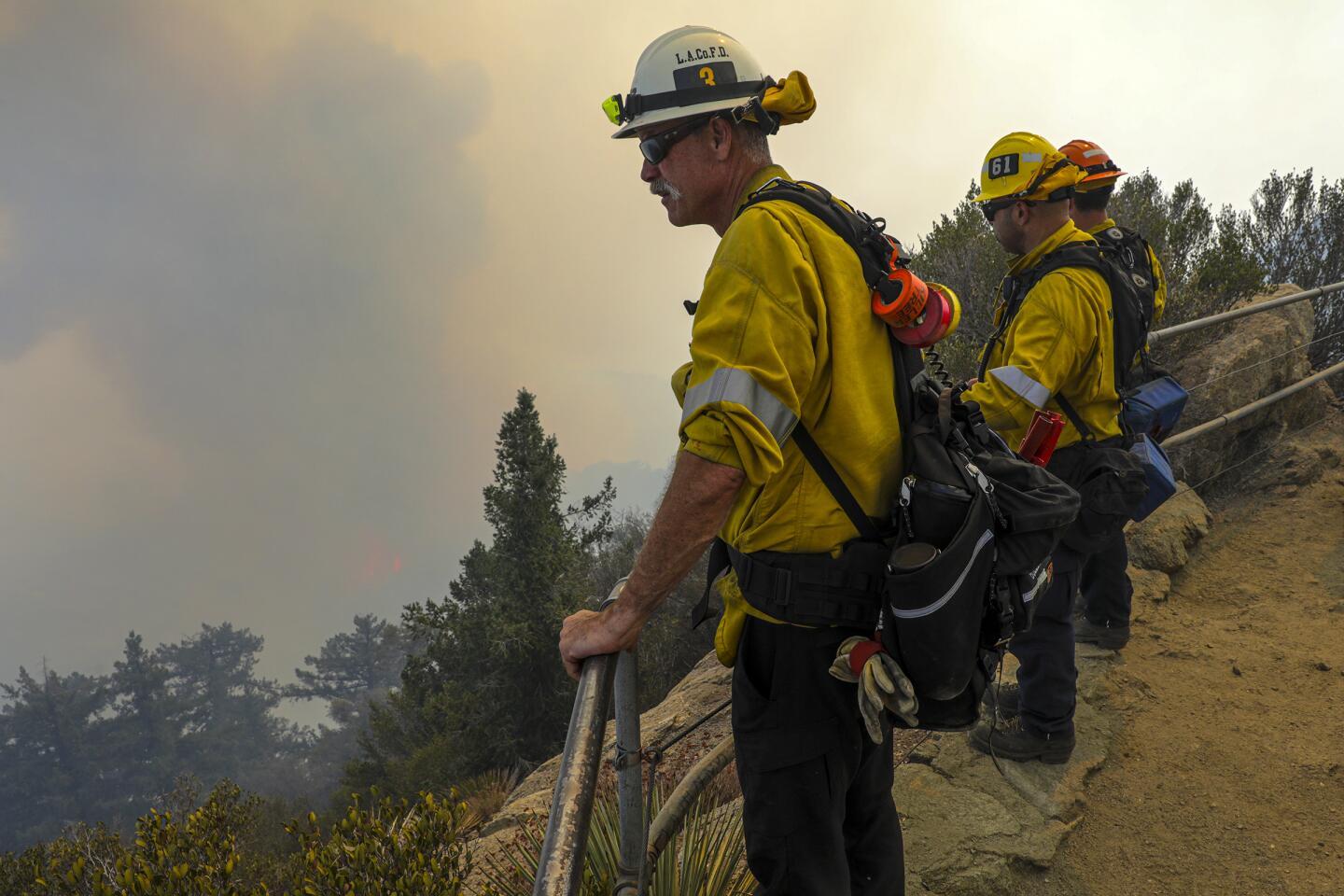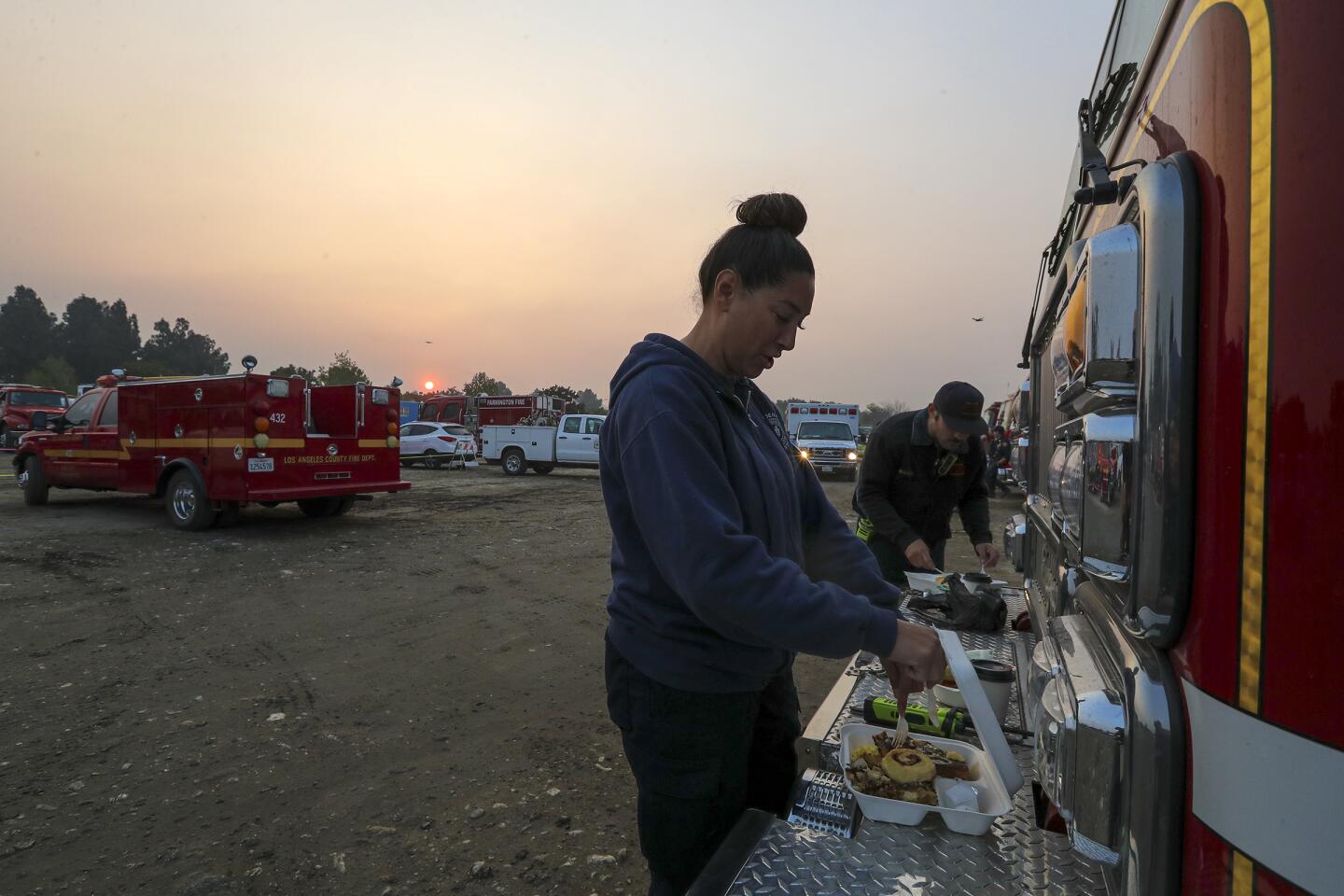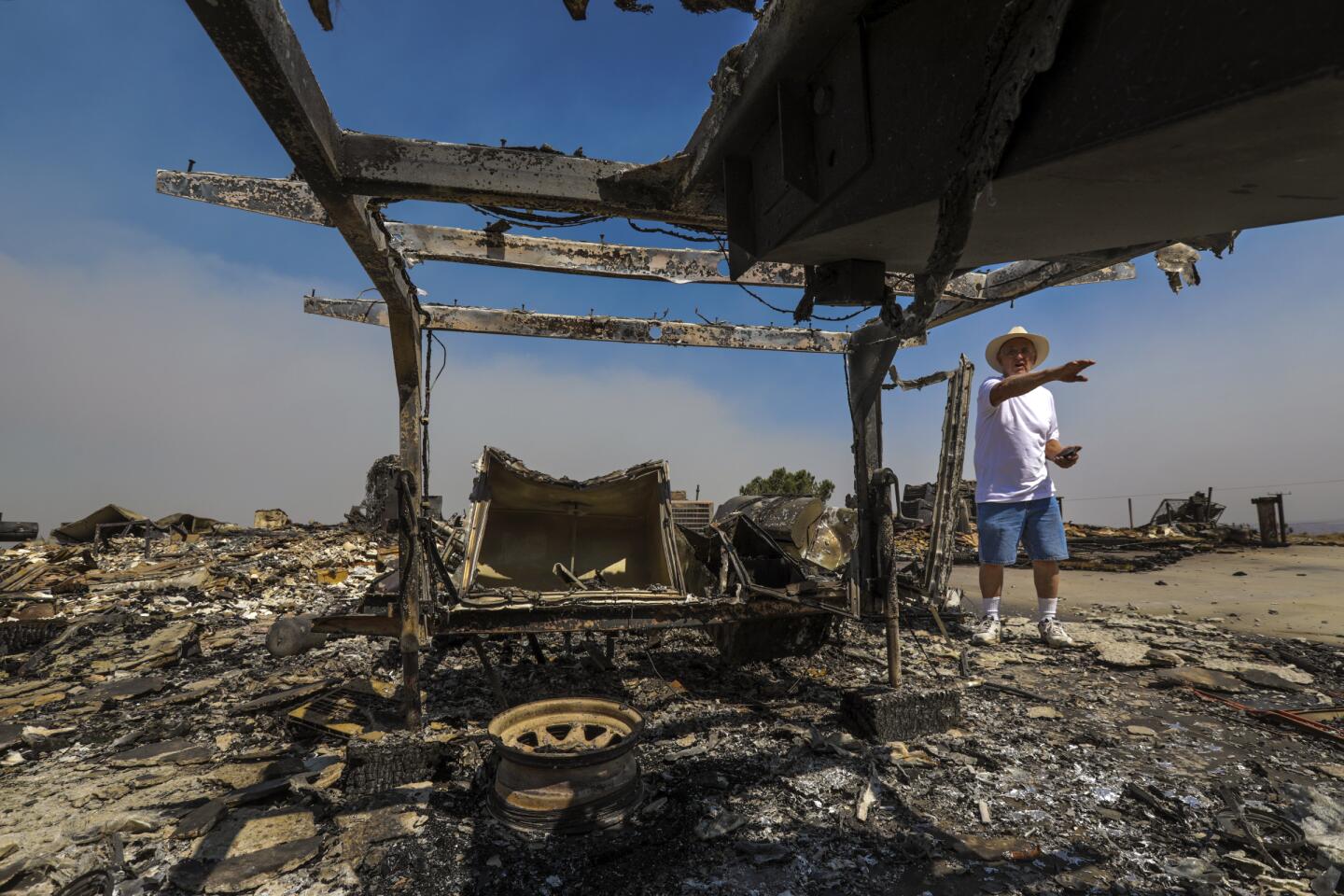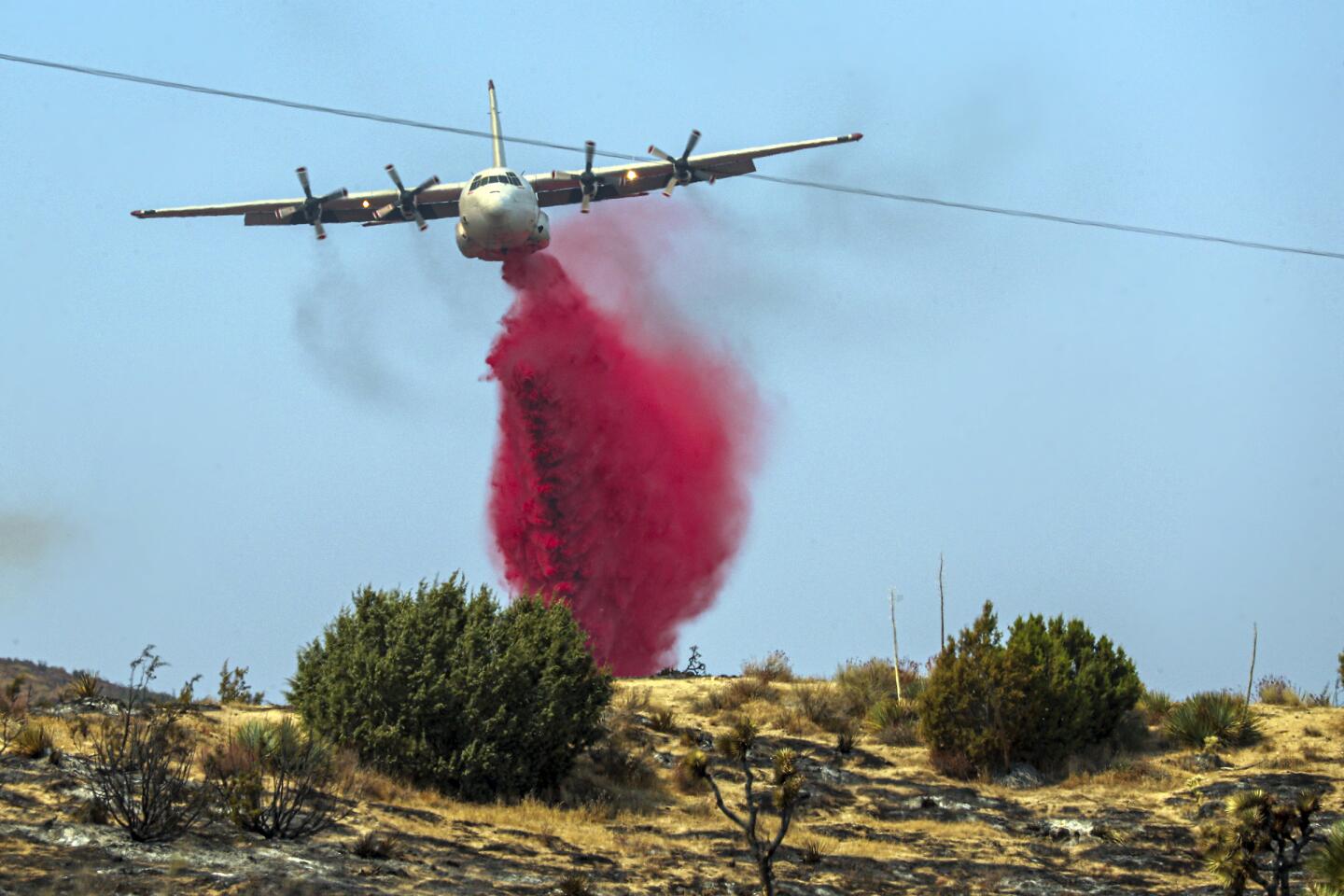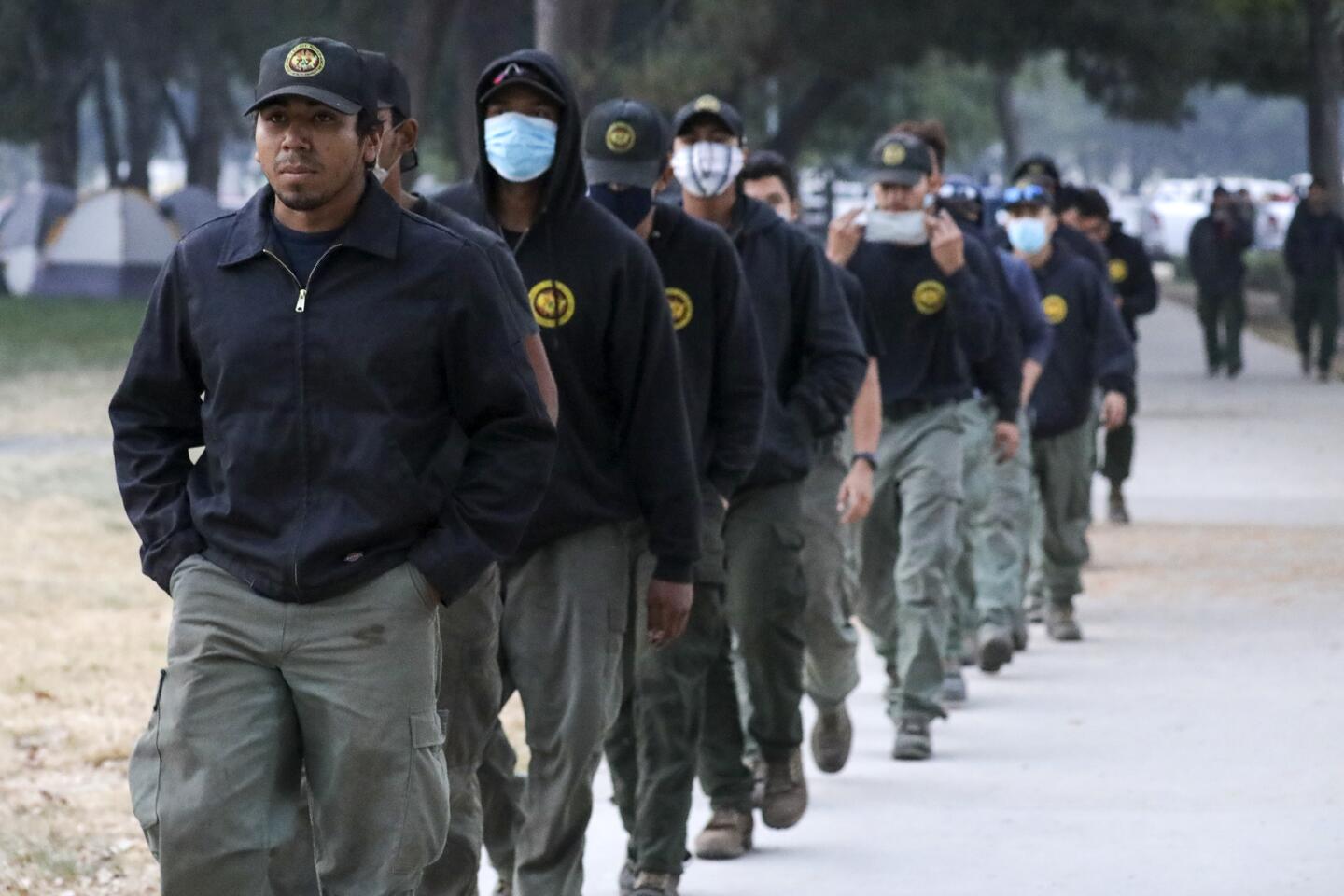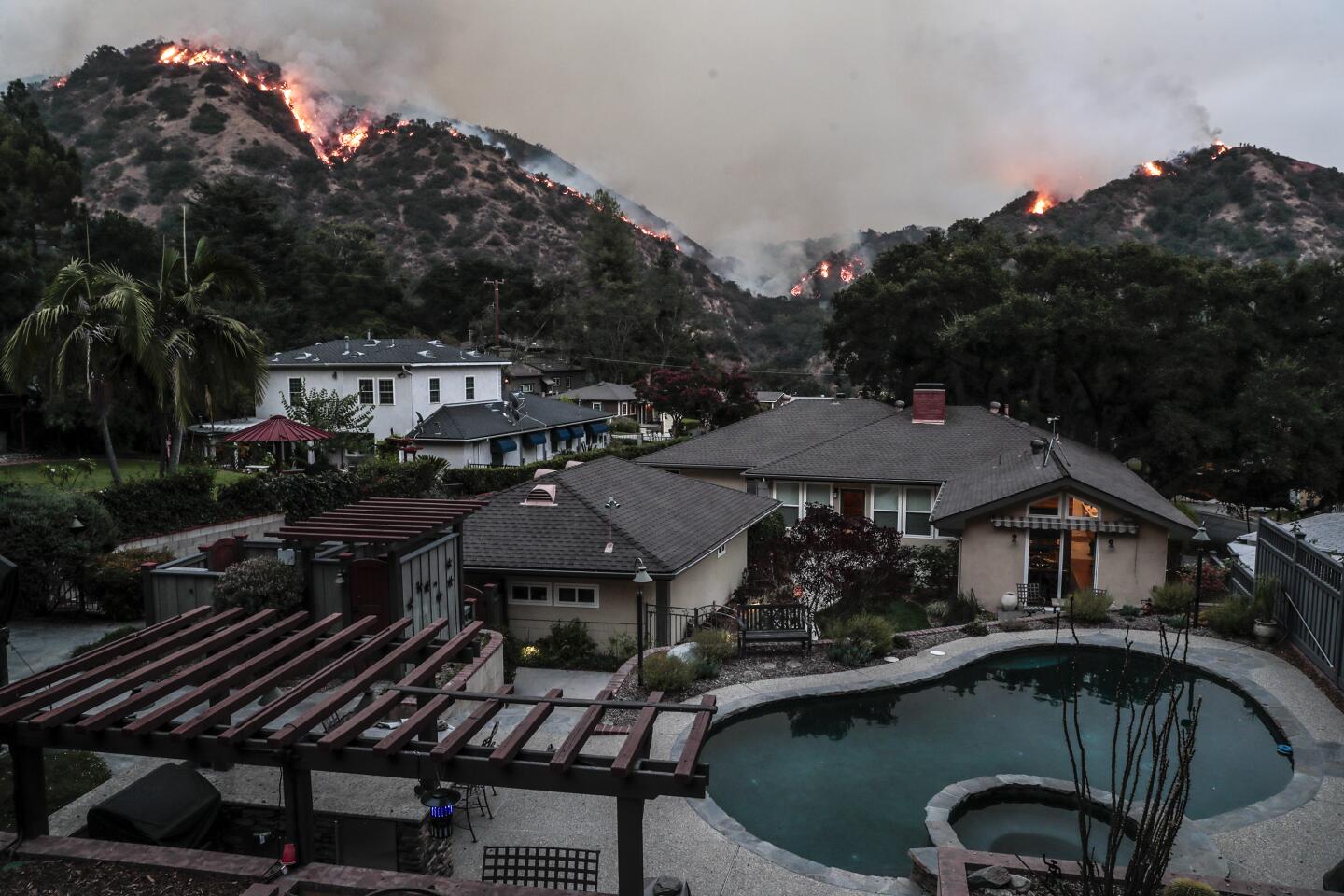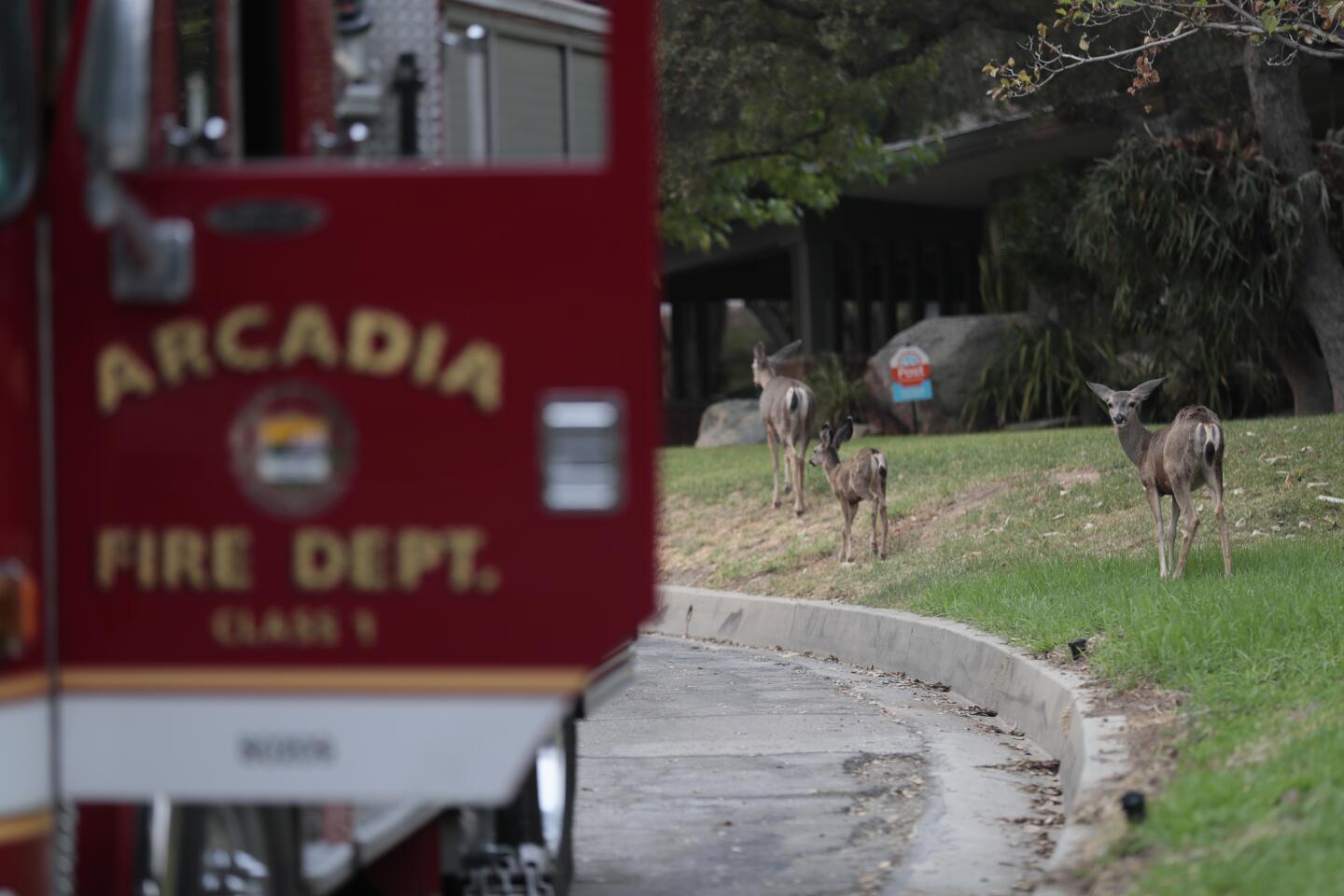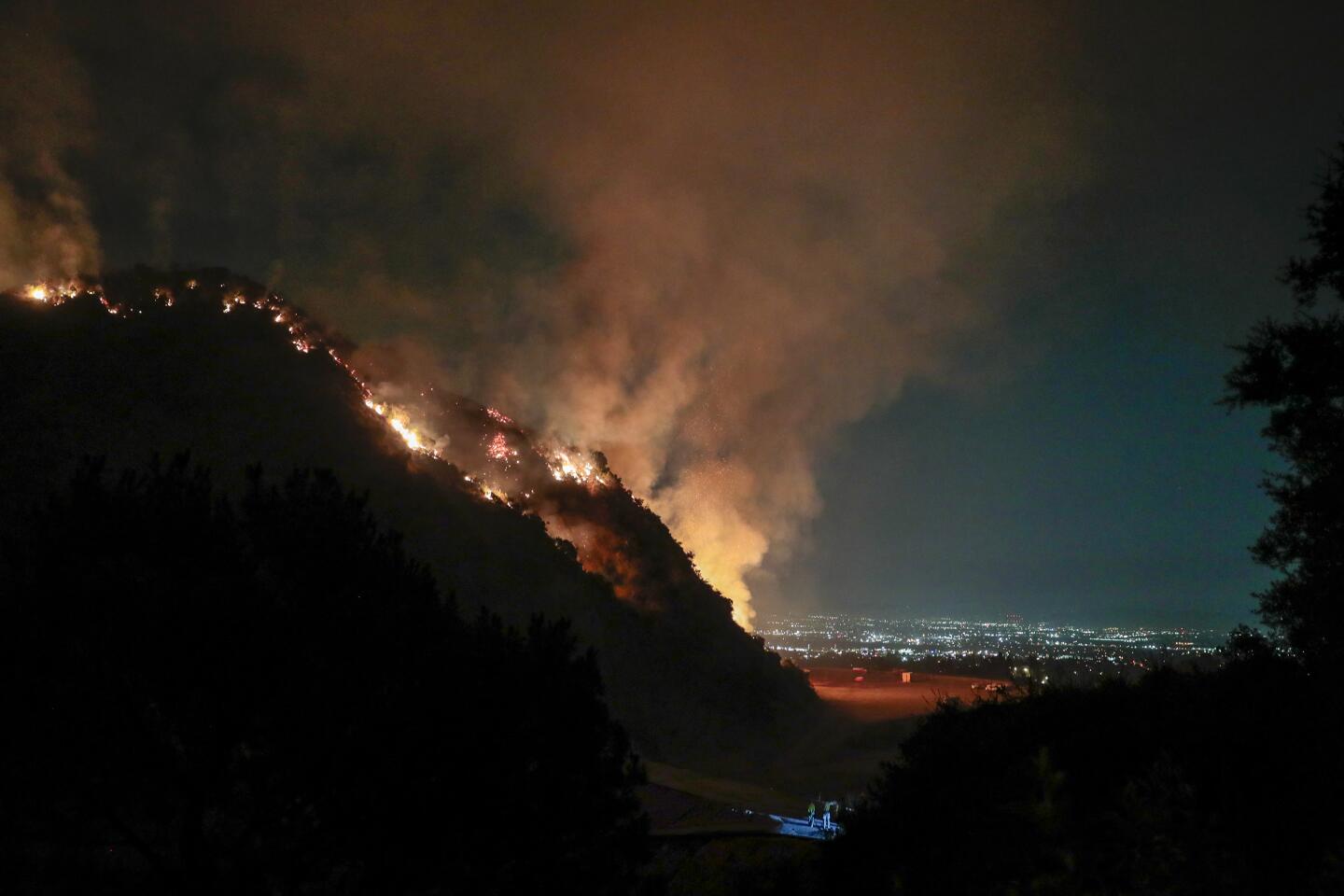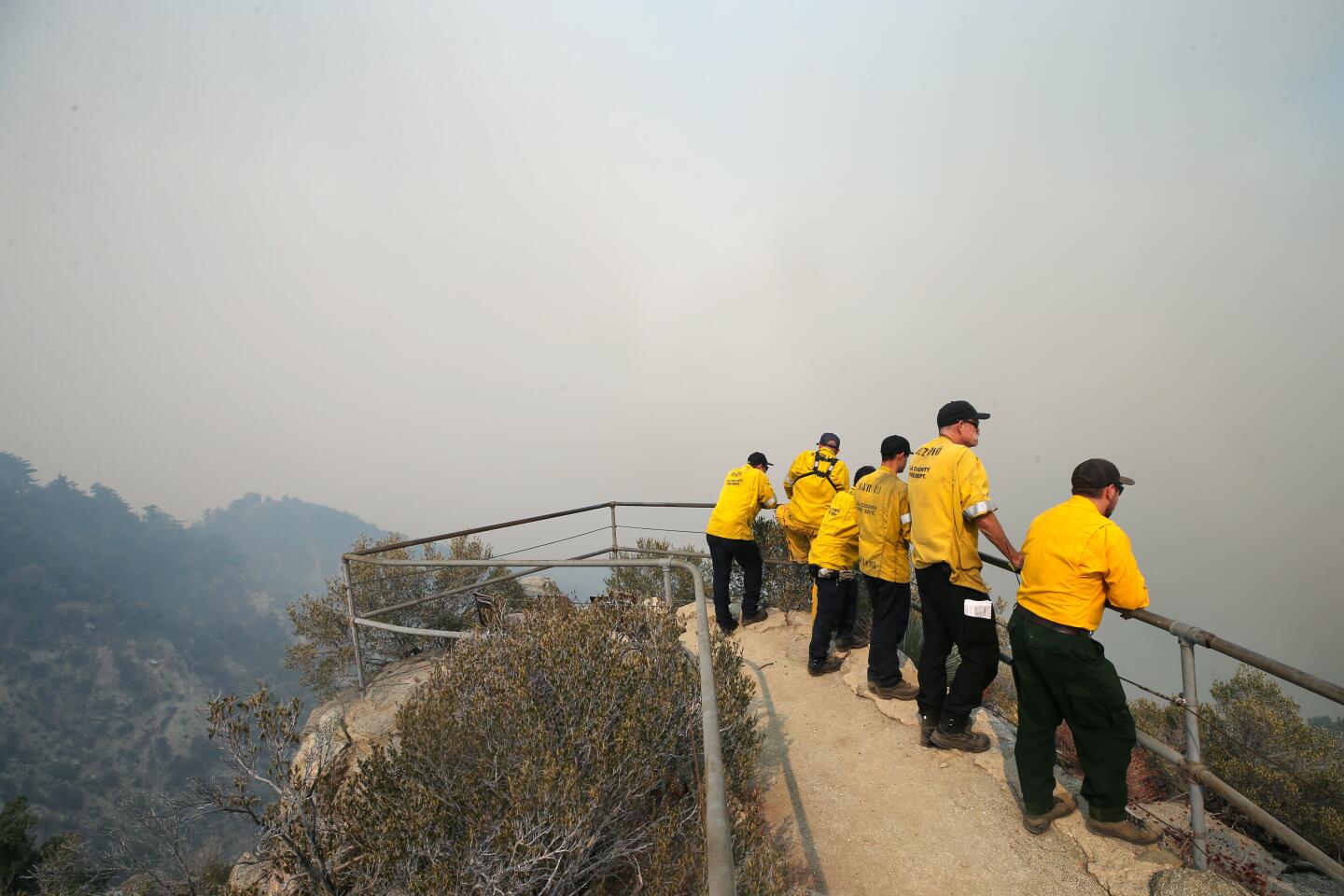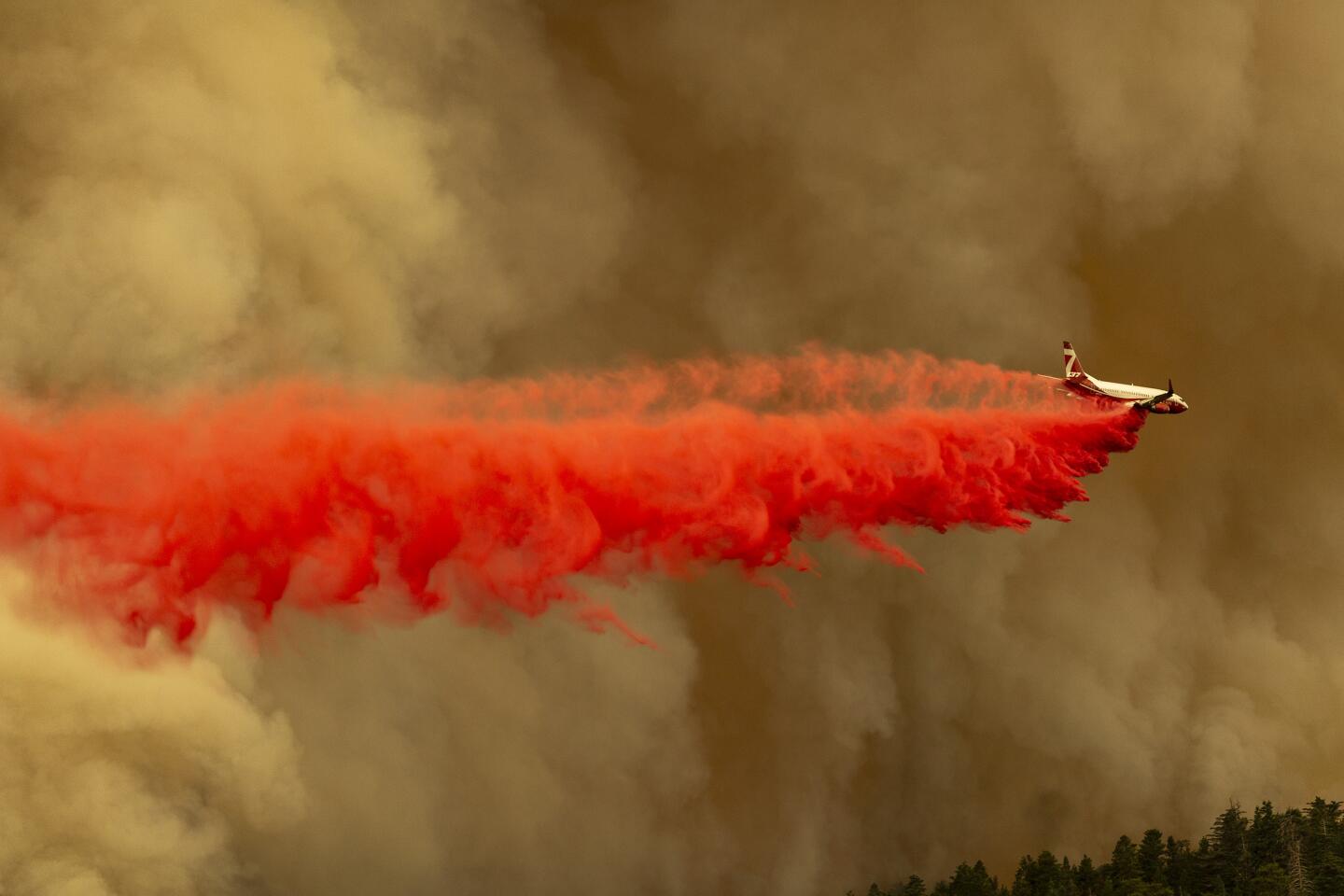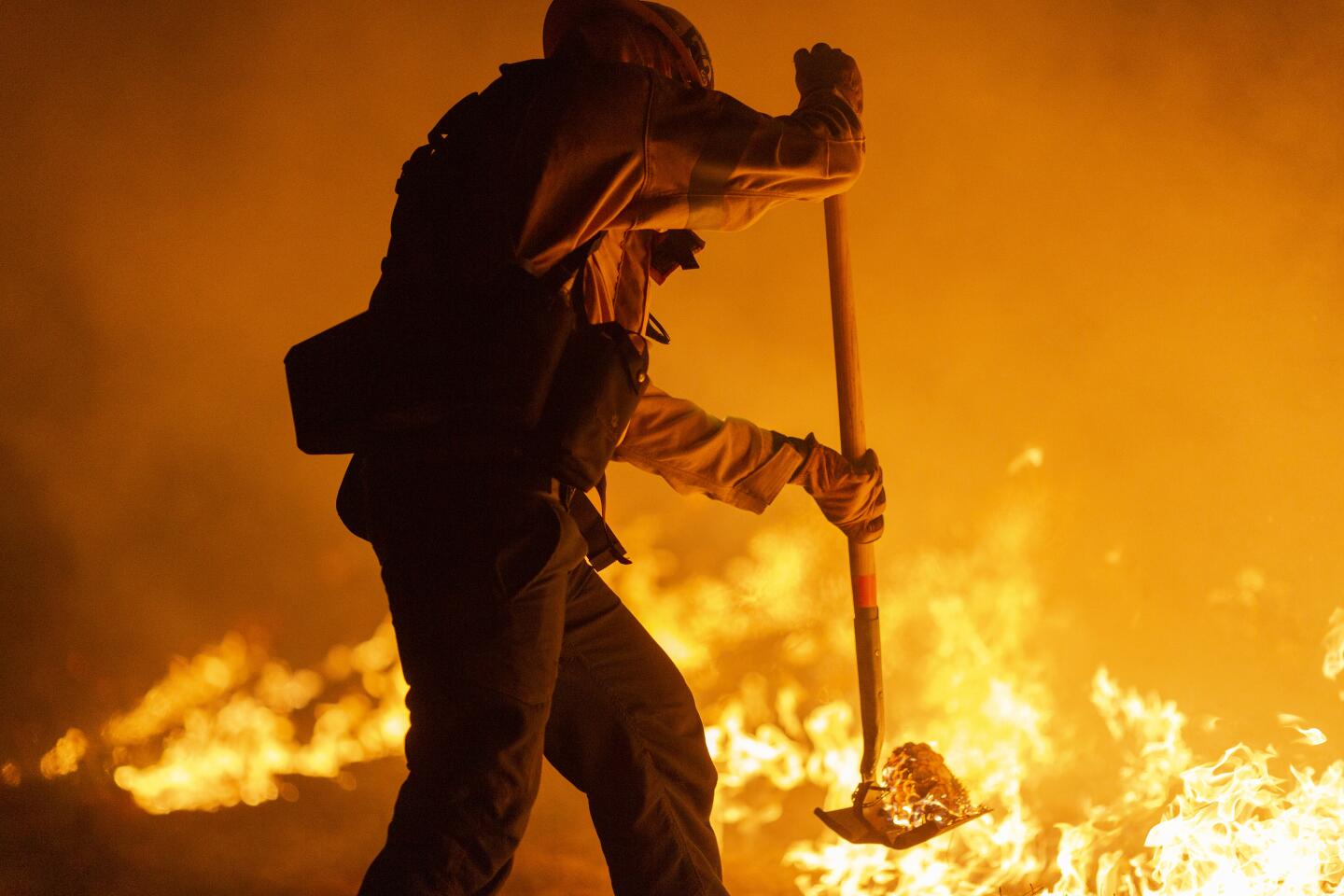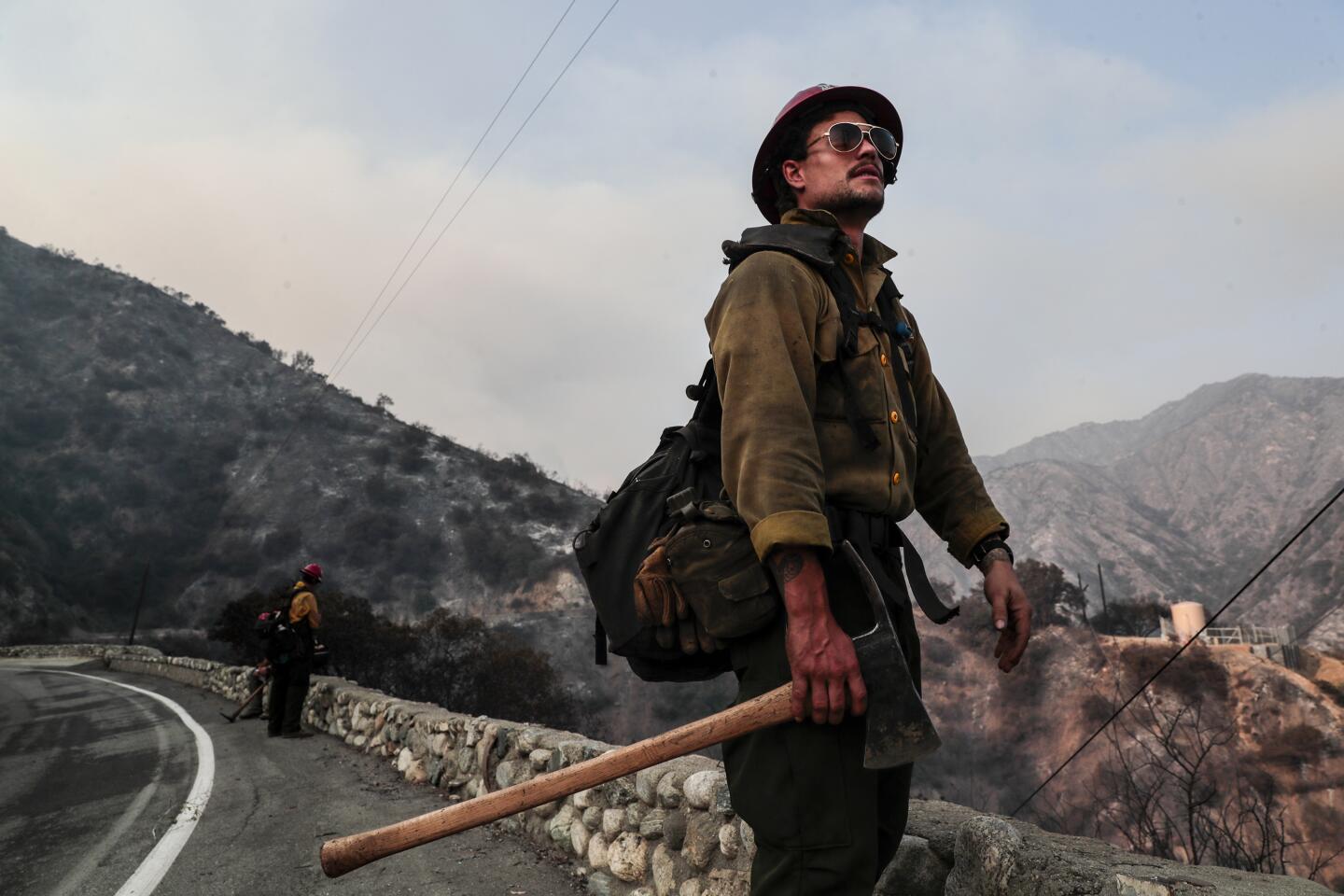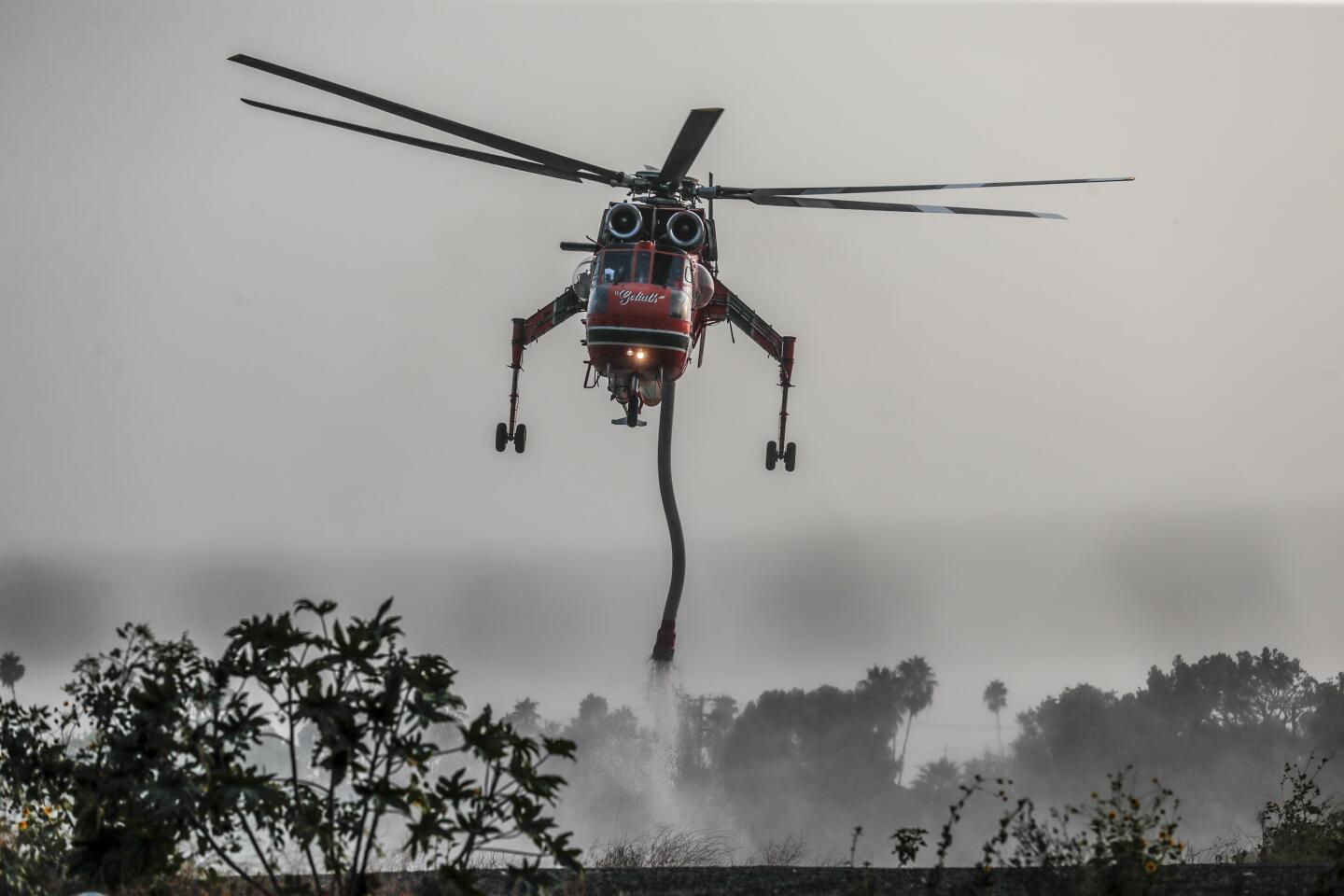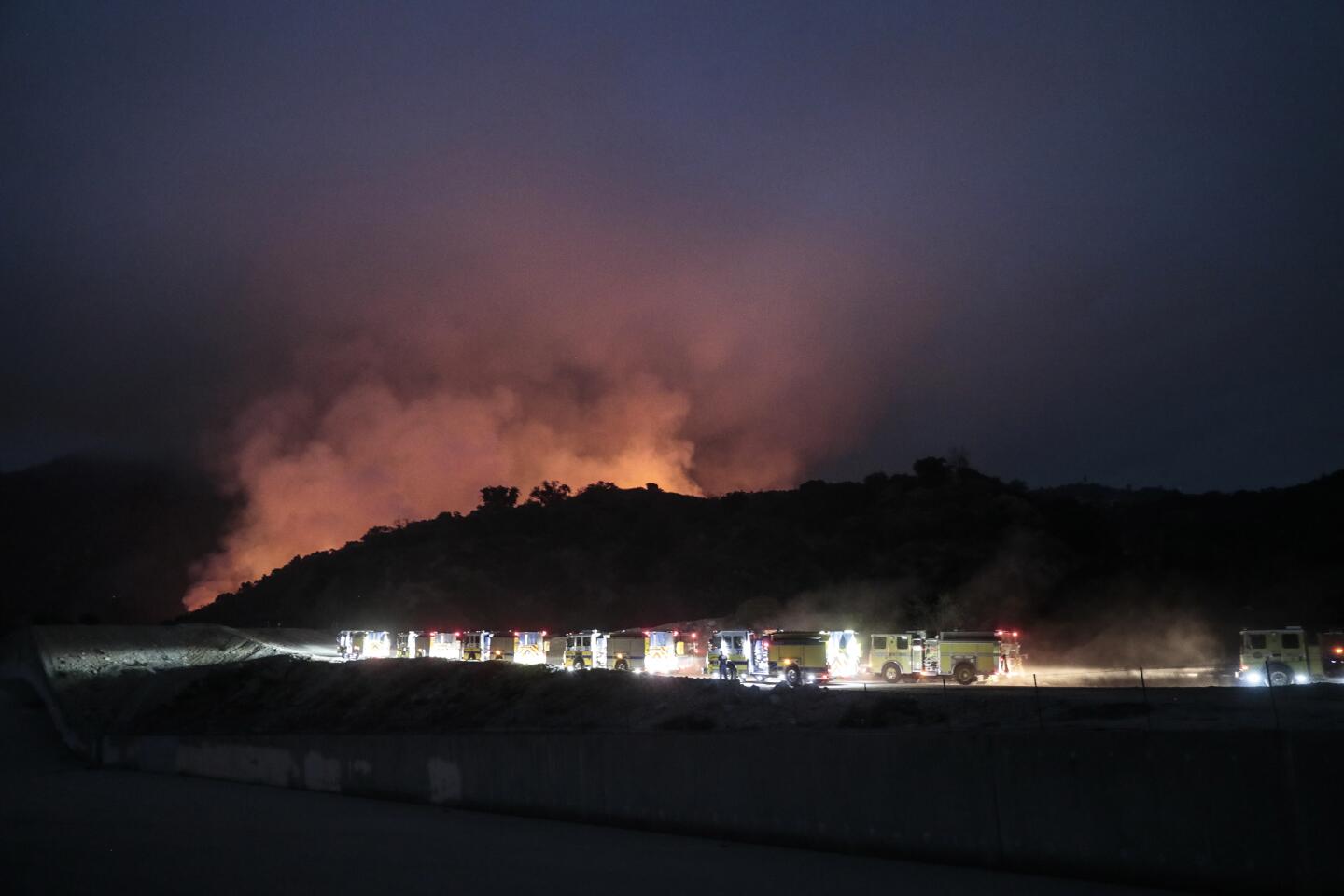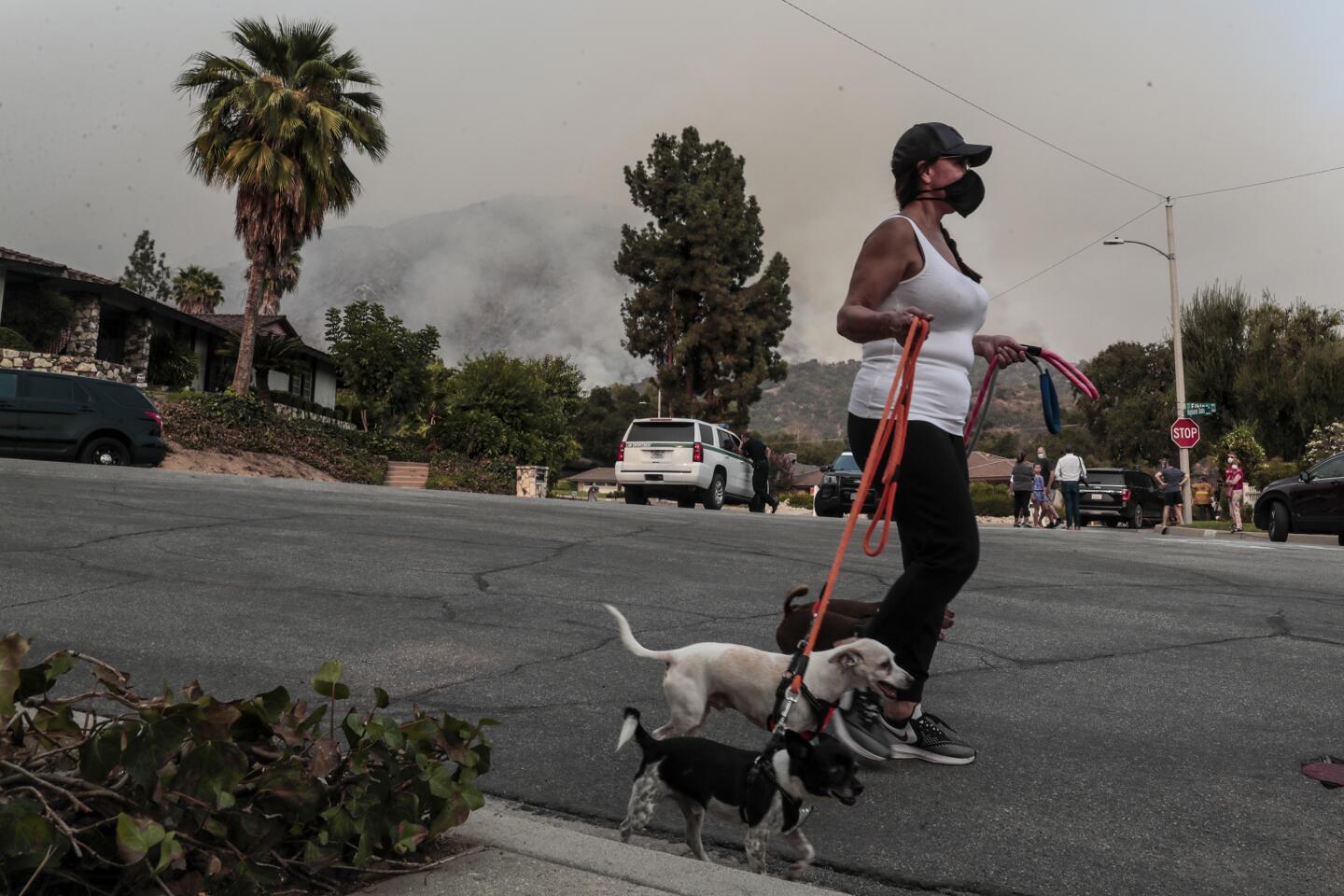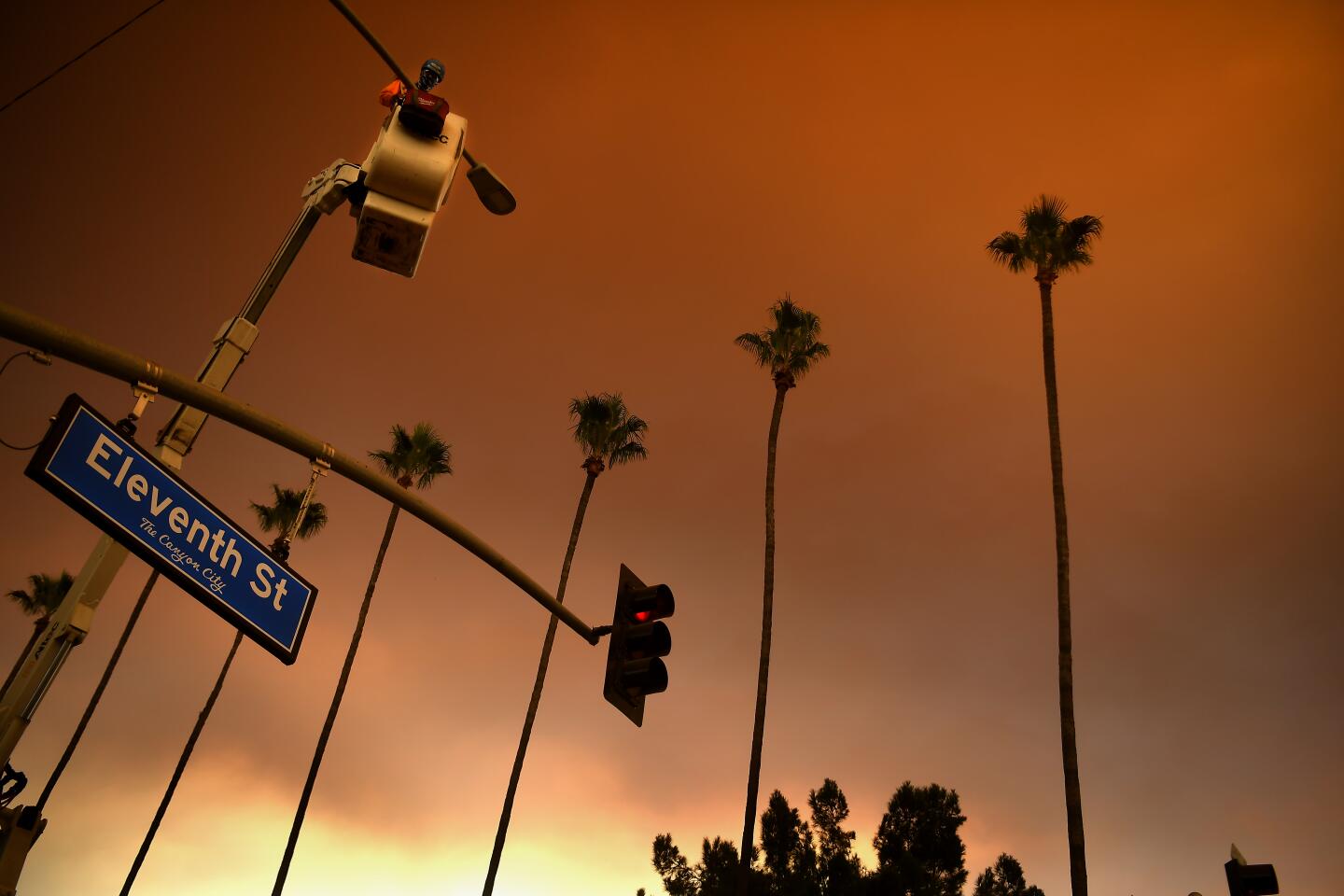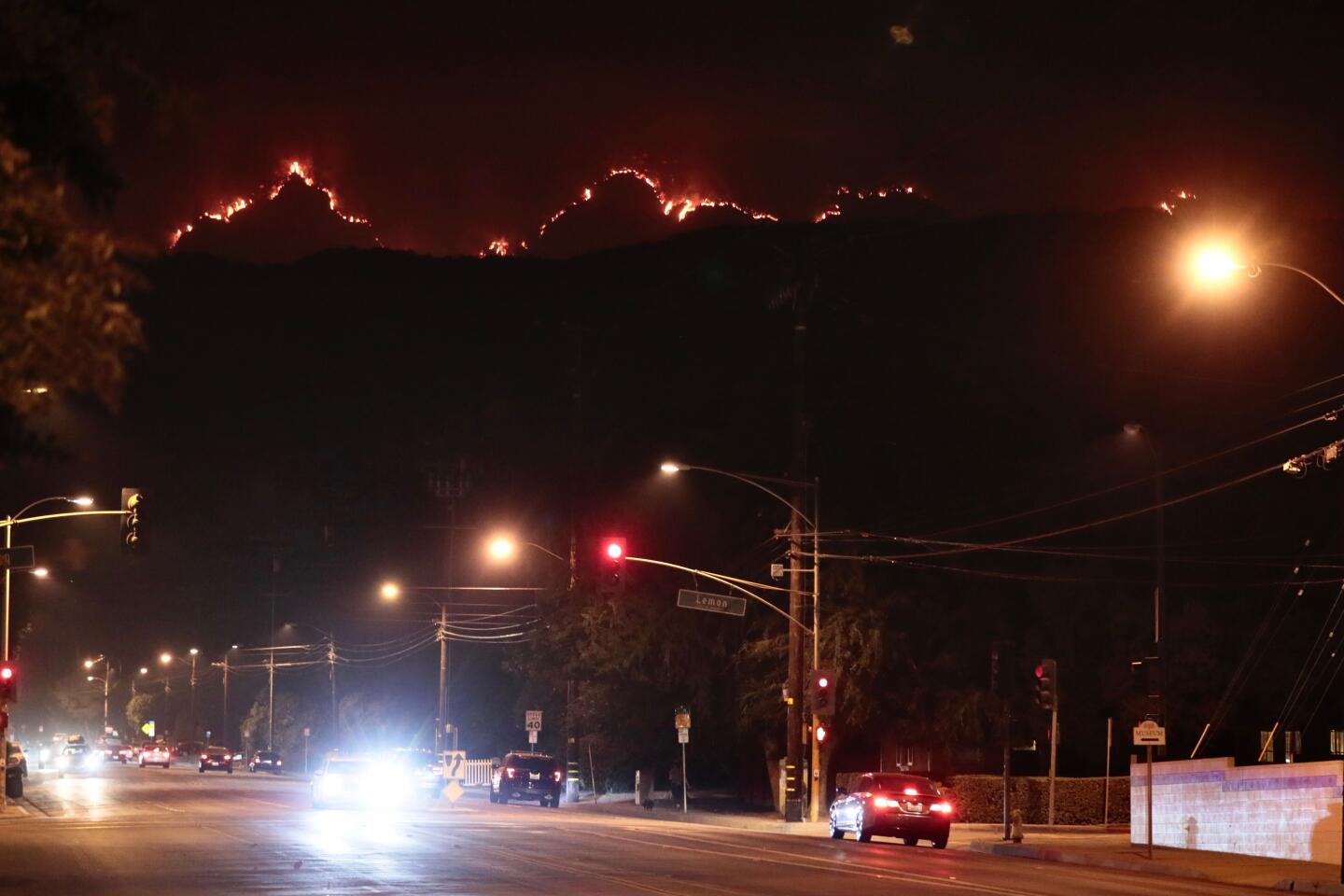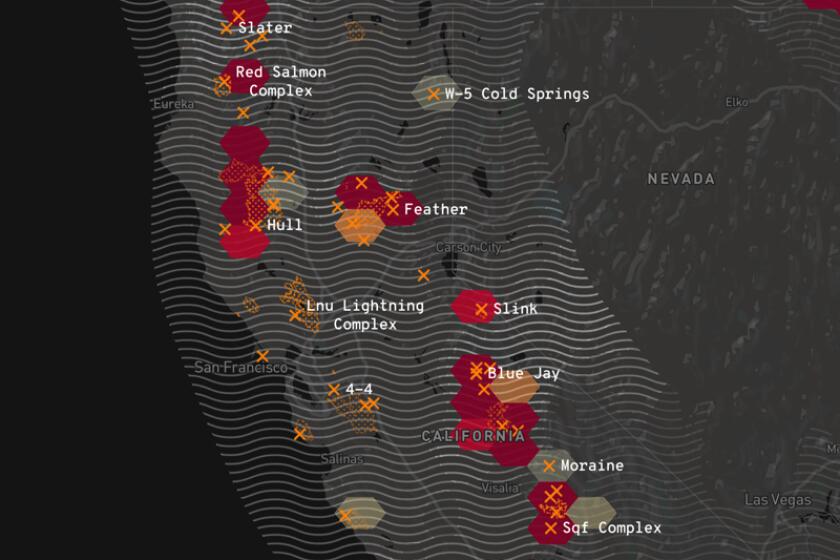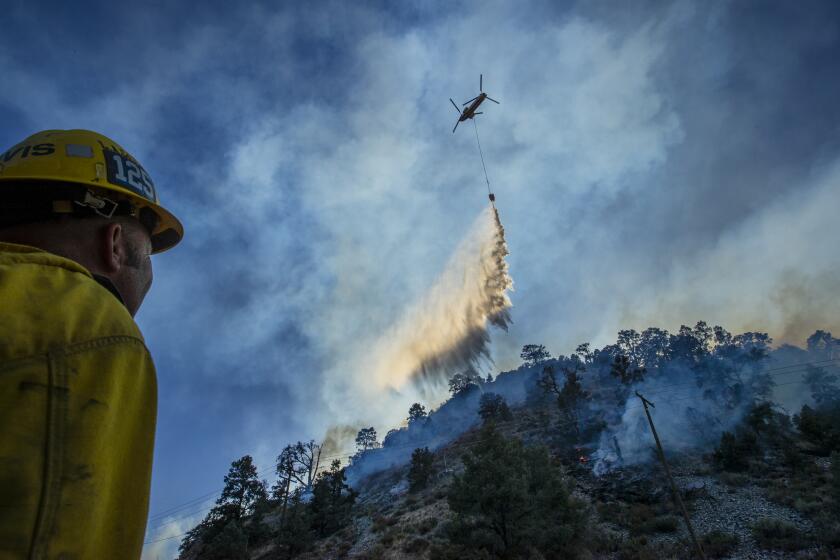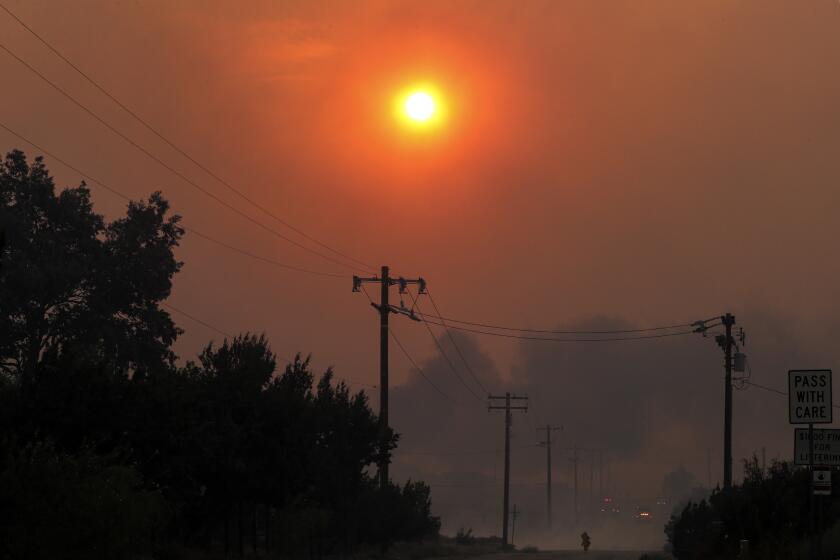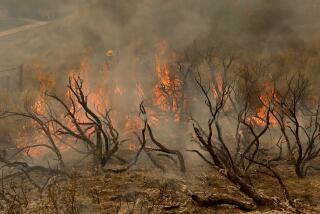Bobcat fire again threatens Mt. Wilson; more evacuations ordered
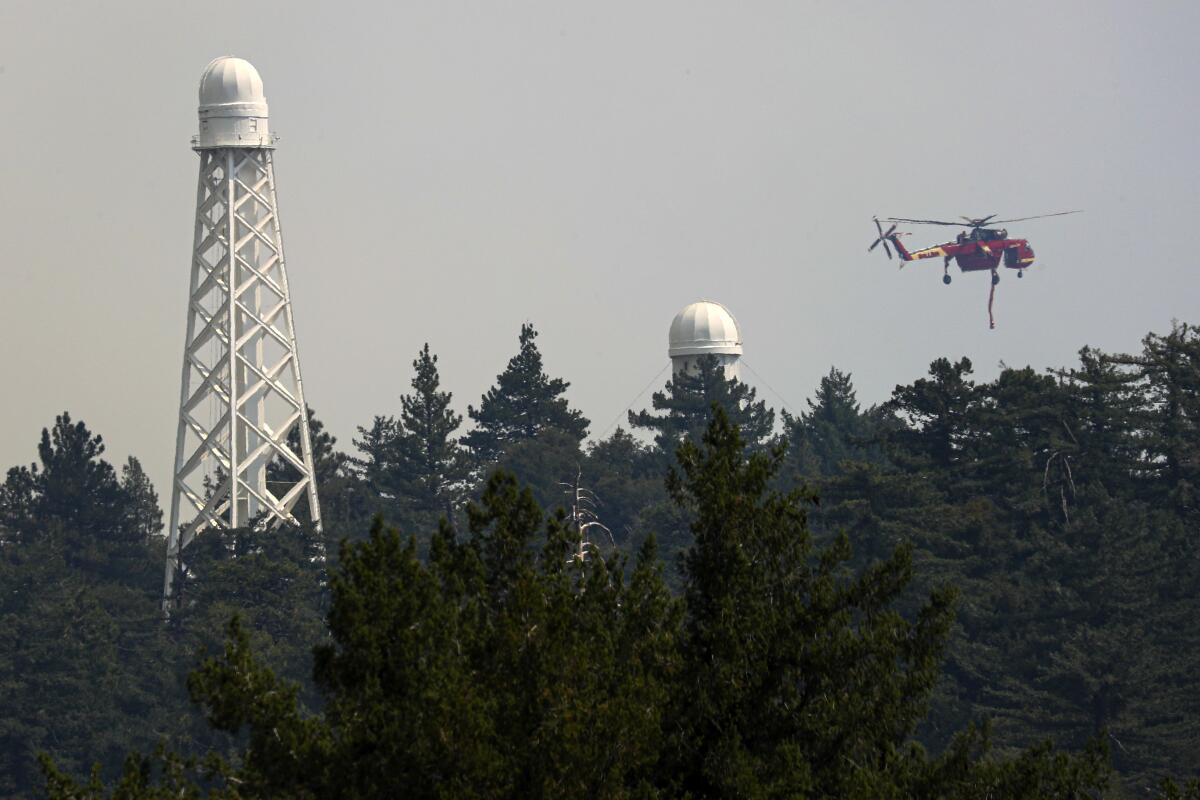
Fire crews remained in battle mode Monday as efforts to save Mt. Wilson from the raging Bobcat fire continued.
Days after officials announced that firefighters had beaten back advancing flames and the 116-year-old Mt. Wilson Observatory was safe, firefighters were battling flare-ups at the top of the mountain. As darkness fell Monday, flames could be seen close to both the observatory and the communications towers on Mt. Wilson.
“Just when I thought the danger was over — it wasn’t,” Thomas Meneghini, the observatory’s executive director, said Monday. “As I was leaving [Sunday], eight more strike units were rumbling up the road.”
It was the second time in a little over a decade that the gleaming white-domed observatory and its companion installations — including the towers that serve broadcast outlets and a variety of law enforcement and national security functions — have faced imminent threat of destruction from wildfire. In 2009, crews battled the Station fire from the ground and the sky over several days.
The Bobcat fire, which ignited Sept. 6, has grown to more than 105,000 acres — one of Los Angeles County’s largest blazes ever — and remains at 15% containment, the U.S. Forest Service said.
The Los Angeles County Sheriff’s Department on Monday afternoon ordered the evacuations of people who live south and west of Upper Big Tujunga Canyon, east of Angeles Forest Highway and north of Angeles Crest Highway.
Firefighters have already used half of a 530,000-gallon water tank on the observatory grounds in their nearly weeklong battle against the blaze, Meneghini said. Crews are working to refill the tank and keep water pressure strong.
Officials from the Forest Service said Mt. Wilson remains a top priority, noting that “multiple, multiple resources” have been dedicated to battling the flames, which continued to burn fiercely through Monday.
“Some of that smoke may have dissipated,” Jerry McGowan, an incident commander, said Monday evening, “but there is quite a bit of fire still down in that hole, down in that area.”
Officials say the fire’s power lies in two factors: location and an inadequate supply of firefighters. But climate experts warn there’s more at play.
Fire crews were also focusing Monday on the Antelope Valley, where the massive blaze continued to loom large after forcing evacuations and charring multiple homes. The National Weather Service said fire weather conditions, including heat, dryness and gusty winds, could feed the flames and create the “potential for rapid growth and extreme fire behavior.”
“Out by the Bobcat fire, it’s still fairly warm and dry, and there will be afternoon and evening gusts of winds,” meteorologist David Sweet said from the weather service’s station in Oxnard. “And that’s the concern right there: dryness and gusty winds.”
Isolated wind gusts could reach as high as 40 mph, Sweet said. The winds will probably continue for the rest of the week.
Residents in the Juniper Hills area of the Antelope Valley anxiously awaited updates on their homes after evacuation orders last week.
“We kept watching the fire maps closely, and we knew that it was in our area,” said Juniper Hills resident Bridget Lensing, who evacuated her family’s home Thursday. “We were hoping and praying somehow our home would be spared.”
Lensing’s parents bought their Cima Mesa home in the 1980s, and she and her brother were raised there. She said that her family rushed to spray the whole property with water before evacuating, and that they spent an agonizing 48 hours away from the area before returning to find much of their neighborhood destroyed.
“All the homes on our street were gone,” Lensing said. “Everything was dust beside the chimneys.”
Lensing’s house was the only one on the street to survive, she said, although it was apparent that flames had swept through the property. Her closest neighbor’s home of 50 years burned in the blaze.
“We feel so, so sorry for them,” she said. “But they want to rebuild.... Juniper Hills is so strong.”
Vince Pena, an incident commander with the Los Angeles County Fire Department, said the Bobcat fire has destroyed or damaged 29 structures, although that tally “could go up to 85 or so” as fire crews continue to assess the damage. An estimated 4,000 people have been displaced from 1,100 homes, he said Monday evening.
The Bobcat fire is one of six major blazes currently prioritized by the state, Gov. Gavin Newsom said Monday during a news briefing. The other fires are the August Complex, the North Complex, the Creek fire, the El Dorado fire and the Snow fire.
“We’re putting all the resources we possibly can on all these complexes,” Newsom said, “but focusing, as we should, on that Bobcat fire.”
Calling this year a historic fire season, the governor said 19,000 firefighters are battling 27 blazes statewide. Among those, 26 people have died, including three firefighters, and 6,400 structures have been destroyed.
“The 26 fatalities and 6,400 structures are based on what we have seen, what we have witnessed,” he said, noting that “by no stretch of the imagination” is that number the extent of potential destruction and death from the fires.
Fifteen mutual-aid states are helping with firefighting efforts statewide, Newsom said, and 3.6 million acres have burned.
The Bobcat fire is moving into some remote areas in the Antelope Valley, destroying homes and prompting numerous evacuations, officials said.
For weeks, firefighters on the Bobcat fire have been hindered by steep, rocky terrain within the Angeles National Forest, which made it difficult for large mechanical equipment to reach several front lines of the blaze.
The fire’s creep into the Antelope Valley, fed by low-lying desert shrubbery, also presents new challenges.
“The more variables you have, the more complex it becomes,” Forest Service spokesman Larry Smith said. “It’s much less terrain-influenced there. Now it’s a fuel-driven fire.”
Grasses, sage and brush are contributing to the fire’s movement through the valley, Smith said, but he noted that the flatter terrain is allowing for more mechanized equipment, such as bulldozers, to create containment lines.
Adding to complications were two private drones being flown in the area late Monday morning, which grounded a fixed-wing aircraft for 30 minutes, the Forest Service said in a tweet.
“If drones are spotted, firefighting aircraft must stay grounded until the area is cleared,” they said.
Mandatory evacuation orders remain in place for multiple areas:
- Juniper Hills, Devil’s Punchbowl and Paradise Springs
- Crystal Lake, the East Fork of the San Gabriel River and Camp Williams
- Residences along Angeles Crest Highway between Angeles Forest Highway and Highway 39
- South of Highway 138, north of Big Rock Creek, east of 87th Street East and west of Largo Vista Road
- South of 138th Street East, north of Big Pine Highway and Highway 2, east of Largo Vista Road and west of 263rd Street East
- South of Highway 138, north of East Avenue W-14, east of 155th Street East and west of 165th Street East.
The Forest Service said Monday the fire had jumped Highway 2 multiple times and is “now on both sides of the road on Barley Flats.”
The following areas remain under evacuation warnings:
- City of Pasadena
- Unincorporated communities of Altadena and Wrightwood
- South of Pearblossom Highway, east and north of Angeles Forest Highway, north and west of Mt. Emma Road, east and south of Highway 122 and west of Chesebro Road
- South of Highway 2, north of Blue Ridge Truck Trail, east of Highway 39 and west of the Los Angeles County border
- South of Avenue U-8, north of East Avenue W-14, east of 121st Street East and west of 155th Street East
- South of Pearblossom Highway, south and east of Pearblossom Highway, north and west of Mt. Emma Road, north and east of Angeles Forest Highway and west of Chesebro Road
- South of Mt. Emma Road, north of Upper Big Tujunga Canyon Road, east of Angeles Forest Highway and west of Pacifico Mountain
An American Red Cross evacuation point has been set up at Palmdale High School for anyone needing assistance.
Officials issued another smoke advisory for part of Southern California through Monday afternoon and parts of the Sierra Nevada have foul air quality.
Air quality continues to suffer because of the fire. Officials issued a smoke advisory for a swath of Southern California through Monday afternoon.
Although forecasts show good or moderate air quality is expected for much of the Southland throughout the day, pollutants could reach levels considered unhealthy for sensitive groups and individuals in the eastern San Gabriel Valley, areas in and around the San Gabriel Mountains and parts of the Inland Empire.
Given the forecast, Los Angeles County health officials are urging residents with heart disease, asthma or other respiratory diseases to minimize their time outdoors.
As of Monday, roughly 1,700 personnel have been assigned to the Bobcat fire, Smith said, including several firefighters who have arrived from across the country to battle the insatiable blaze.
“Is there a fatigue level? Absolutely,” Smith said, “but firefighters are always optimistic. I never go into a fight with the intent to lose.”
Times staff writer Luke Money contributed to this report.
More to Read
Sign up for Essential California
The most important California stories and recommendations in your inbox every morning.
You may occasionally receive promotional content from the Los Angeles Times.
